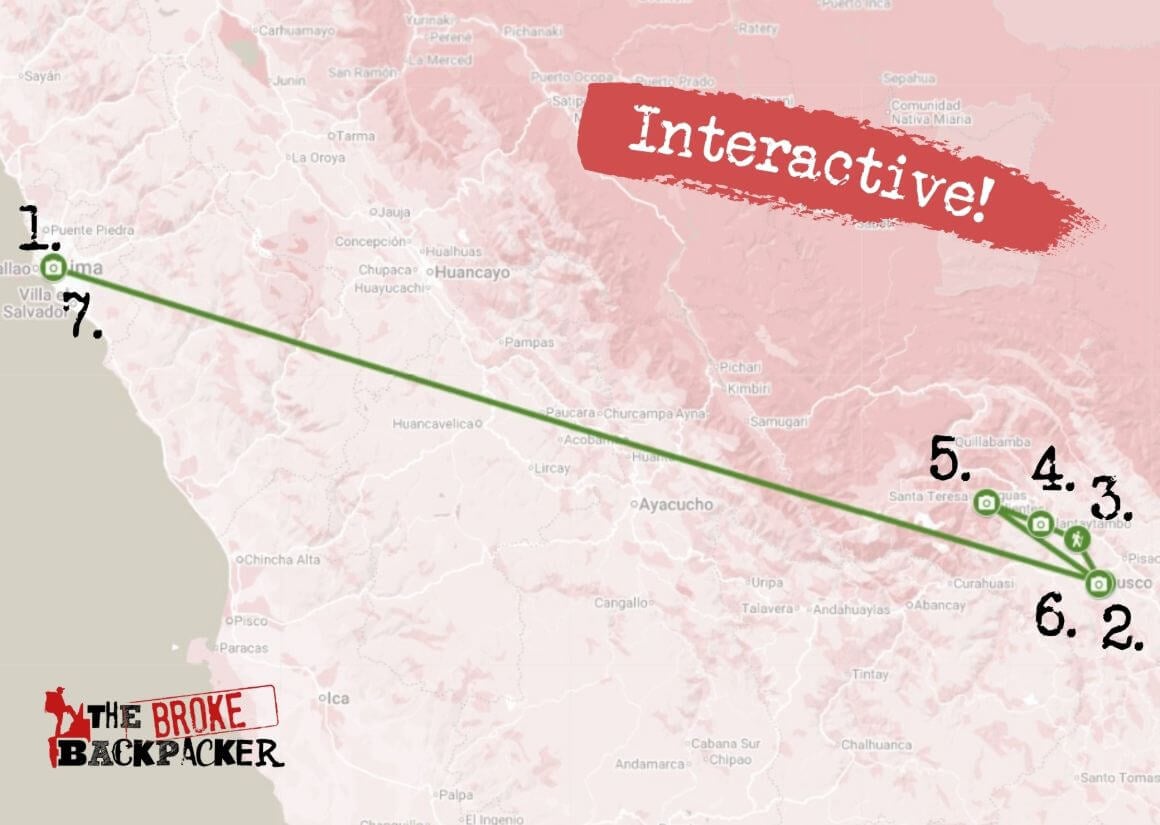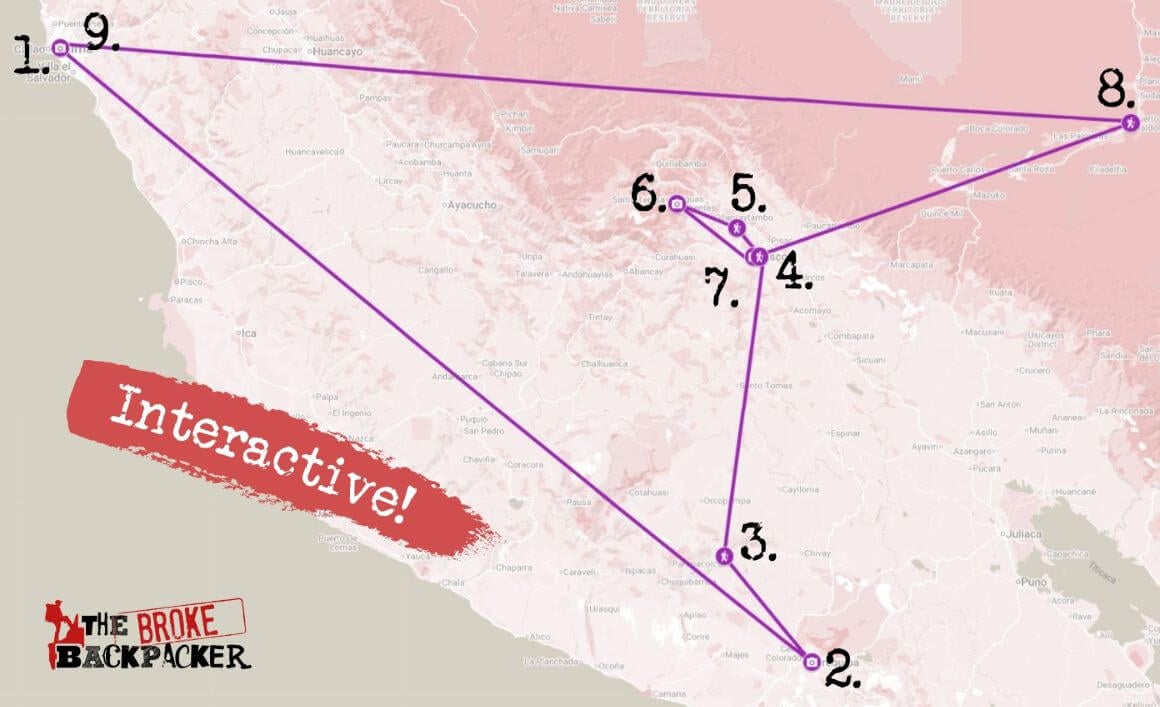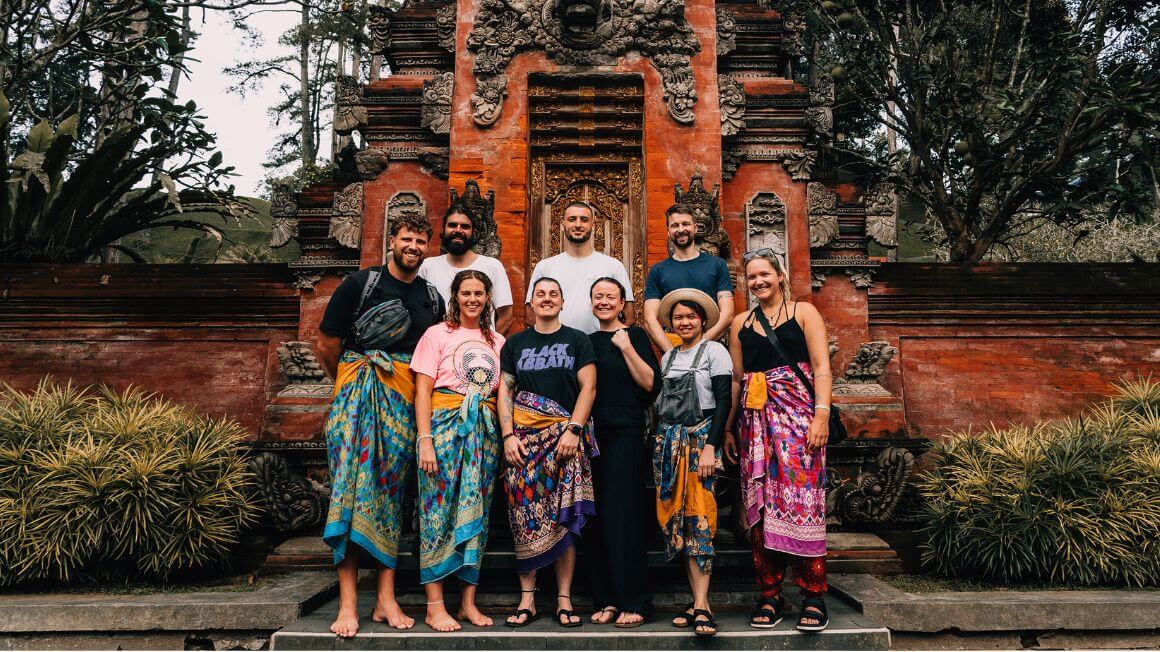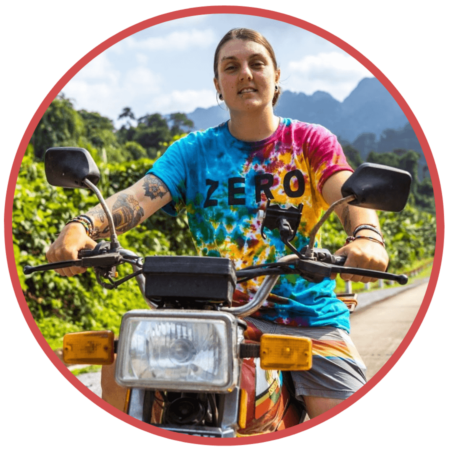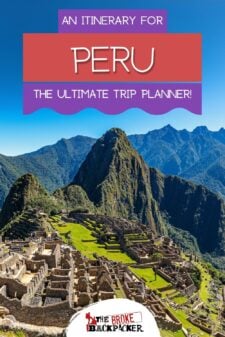The Broke Backpacker is supported by you. Clicking through our links may earn us a small affiliate commission, and that's what allows us to keep producing free content 🙂 Learn more.
Peru isn’t just another destination in South America – it’s a full-blown sensory overload. Think misty mountains, jungle trails, ancient ruins, and bustling markets where you’ll find yourself haggling with a granny over mangoes. It’s wild, it’s thrilling, and it packs some of the most breathtaking landscapes on Earth.
Planning a trip to Peru and feeling overwhelmed? Don’t stress. Our 7-day itinerary hits the essentials (DUH of course Machu Picchu is included!!), plus offbeat hidden gems, local eats and no-fuss travel tips to keep things smooth.
Sounds good? Let’s take it up a notch and add three days to the mix. Now we’ve got a 10-day itinerary for Peru, for those who’d like to linger a little longer.
So, whether you’re a seasoned traveller or booking your first South American adventure, planning your next trip to Peru is on us. Pack light, lace up, and let’s make Peru happen.
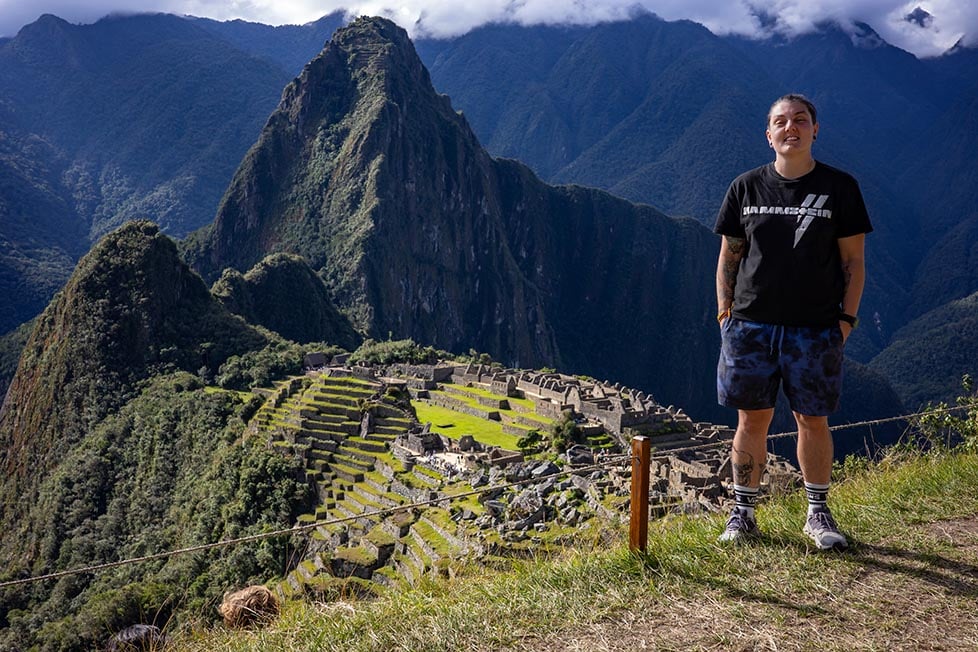
Photo: Nic Hilditch-Short
The Broke Backpacker is supported by you. Clicking through our links may earn us a small affiliate commission, and that's what allows us to keep producing free content 🙂 Learn more.

Unlock Our GREATEST Travel Secrets!
Sign up for our newsletter and get the best travel tips delivered right to your inbox.
- Best Time to Visit Peru
- Where to Stay in Peru
- 7 Days Itinerary in Peru
- Day 1 in Peru: Lima
- Day 2 in Peru: Fly to Cusco
- Day 3 in Peru: Sacred Valley
- Day 4 in Peru: Ollantaytambo
- Day 5 in Peru: Aguas Calientes (Machu Picchu)
- Day 6 in Peru: Cusco Hidden Gems
- Day 7 in Peru: Lima
- 10-Day Itinerary in Peru
- Day 2 in Peru: Arequipa
- Day 3 in Peru: Colca Canyon
- Day 4 in Peru: Cusco
- Day 5 in Peru: Sacred Valley + Ollantaytambo
- Day 6 in Peru: Aguas Calientes (Machu Picchu)
- Day 7 in Peru: Cusco (Rainbow Mountain Trek)
- Day 8 & 9 in Peru: Puerto Maldonado
- Day 10 in Peru: Lima
- How to Get Around Peru
- Staying Safe in Peru
- Final Thoughts
- Buy Us a Coffee!
Best Time to Visit Peru
Peru’s diverse landscape means its climate varies – from coast to jungle to mountains, each region follows its own rhythm. The best overall time to visit Peru is from May to September.
- May to September (high season) – best time for mountain treks
The Andes and Sacred Valley have clear skies and cooler temperatures, making it perfect for hiking Machu Picchu or wandering Cusco. However, expect bigger crowds and higher prices, especially from June to August. - April, October (shoulder season) – sweet spot of decent weather & fewer crowds
- November to March (low season) – rainy season, avoid treks, hit the beaches.
The rainy season hits hard in the mountains. Trails can be muddy or closed, so it’s best to avoid these months if you’re trekking. On the flip side, it is sunny in Lima and the coast, ideal for beach days. Whatever your Peru trip looks like, I’m here to help you plan the ideal time to visit.
Here’s a monthly breakdown of the weather to help you plan your trip to Peru:
| Month | Avg Temp. | Rain Chance | Crowds |
|---|---|---|---|
| January | 12°C – 20°C | High in the mountains, low on the coast | Low |
| February | 12°C – 20°C | High in the mountains, low on coast | Low |
| March | 12°C – 21°C | Moderate everywhere | Medium |
| April | 11°C – 21°C | Low | Medium |
| May | 10°C – 20°C | Very low | Medium |
| June | 9°C – 19°C | Very low | High |
| July | 8°C – 18°C | Very low | High |
| August | 8°C – 19°C | Very low | High |
| September | 9°C – 20°C | Low | Medium |
| October | 10°C – 21°C | Low | Medium |
| November | 11°C – 22°C | High in the mountains | Medium |
| December | 12°C – 22°C | High in the mountains, low on coast | Medium |
7-Day Peru Itinerary Overview
- Day 1 in Lima : Barranco, Miraflores Malecon
- Day 2 in Cusco: San Blas, Qorikancha, San Pedro
- Day 3 in Sacred Valley: Pisac market, Chinchero Weaving, Moray and Maras salt mines
- Day 4 in Ollantaytambo: Ollantaytambo Ruins
- Day 5 in Aguas Calientes (Machu Picchu): Machu Picchu, Huayna Picchu + Sun Gate
- Day 6 in Cusco Hidden Gems: Temple of the Moon or Sacsayhuamán, Museo de Arte Precolombino, Chocolate-making workshop
- Day 7 in Lima: Surquillo Market
10-Day Peru Itinerary Overview
- Day 1 in Lima: Barranco, Miraflores Malecon
- Day 2 in Arequipa: Plaza de Armas, Santa Catalina Monastery
- Day 3 in Colca Canyon: Cruz del Condor, Chivay & Yanque, La Calera Hot Springs
- Day 4 in Cusco: San Blas, Qorikancha, San Pedro
- Day 5 in Sacred Valley: Pisac market, Ollantaytambo Ruins
- Day 6 in Aguas Calientes (Machu Picchu): Machu Picchu, Huayna Picchu + Sun Gate
- Day 7 in Rainbow Mountain: Vinicunca Rainbow Mountain
- Day 8 & 9 in Puerto Maldonado: Canopy Walk, Night Trail + Caiman Spotting, Morning River Wildlife Excursion, Oxbow Lake
- Day 10 Return to Lima
Where to Stay in Peru
When deciding where to stay in Peru, consider making one city your base. The accommodation scene in Peru centres around two key cities: Lima and Cusco. Most travellers bounce between these two and the Sacred Valley. This triangle covers the coast, the mountains and jungle access.
In Lima, the best place to stay is Miraflores. Apart from the cliffs, cafes, and surf scene., Miraflores also offers international standards, with English-speaking staff and easy airport access. If you want to experience authentic Lima culture, head to Barranco – Lima’s bohemian alternative, with indie galleries, street art and live music.
Cusco is one of the best places to stay in Peru. It is your mountain base. Stay close to the Historic Centre for easy access to museums, markets, and the archaeological ruins. You can also base yourself in the artisan quarter of San Blas, popular for its cobbled alleys and coffee spots. These two will have you within walking distance from Peru’s attractions and keep transportation costs minimal.
In the Sacred Valley, places like Ollantaytambo and Urubamba are scenic, chilled, and perfectly placed between Cusco and Machu Picchu.
Hotel Antigua Miraflores | Best Budget Hotel in Peru
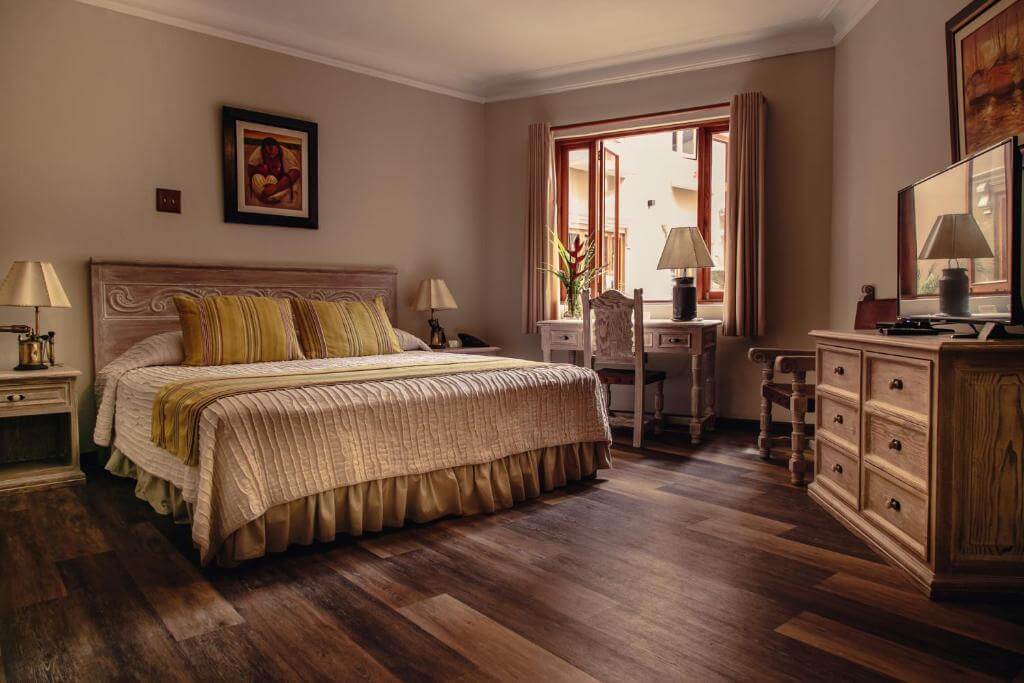
Antigua Miraflores blends colonial charm with modern comfort in Lima’s safest district. This restored mansion features original tilework and courtyards that transport you back centuries. Located steps from the Malecón cliff top walkway, you’ll have Pacific sunset views and easy access to Lima’s best ceviche spots without breaking the budget.
JW Marriott El Convento Cusco | Best Luxury Hotel in Peru
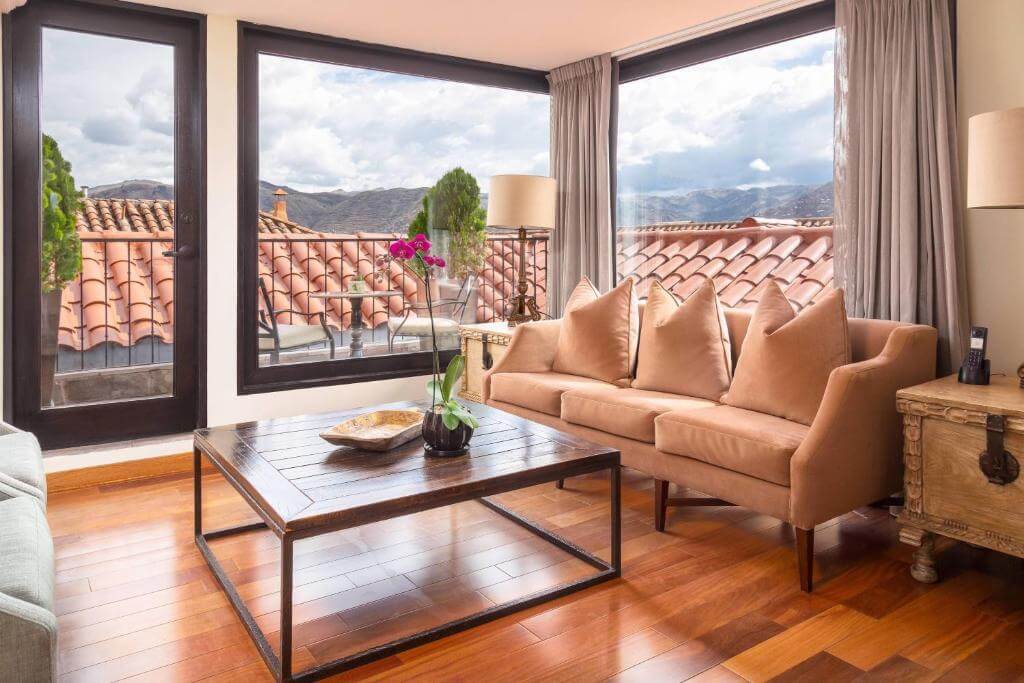
JW Marriott El Convento Cusco is a 16th-century convent transformed into a luxury hotel with oxygen-enriched rooms to combat altitude sickness. The hotel’s central courtyard preserves original colonial architecture while modern amenities include a world-class spa and gourmet restaurant. Its location in San Blas puts attractions like Qorikancha temple and artisan workshops within walking distance.
Supertramp Hostel | Best Hostel in Peru
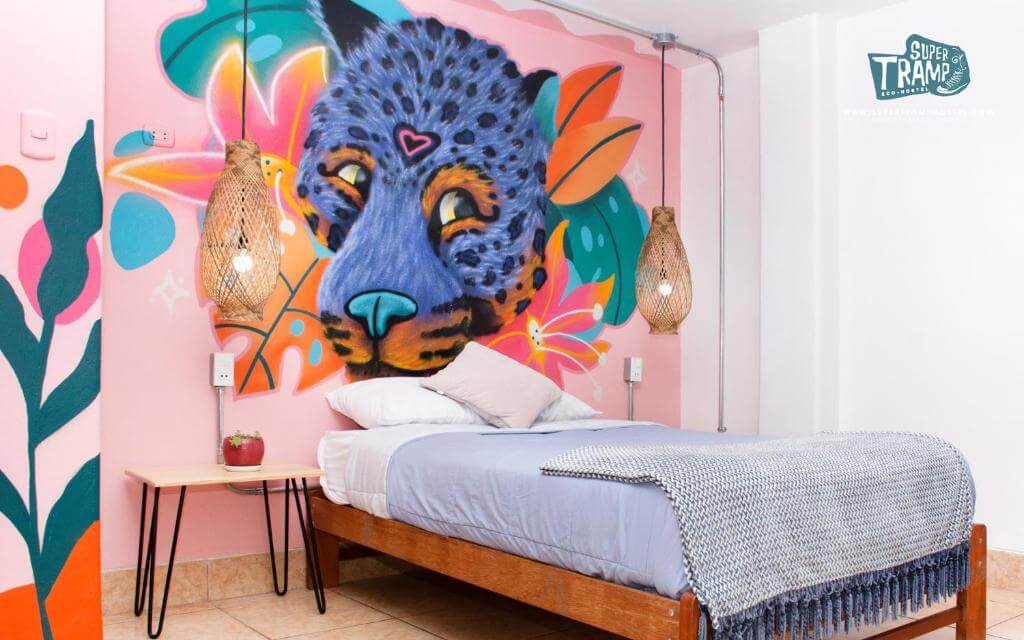
Located close to Machu Picchu, this Peru hostel promises amazing mountain views from its rooftop terrace that will make your morning coffee unforgettable. Don’t forget to take the perfect photos for your ‘gram! The hostel provides hot showers and reliable Wi-Fi, which is perfect for your stay before and after trekking to Machu Picchu.
7 Days Itinerary in Peru
Day 1: Lima | Day 2: Fly to Cusco | Day 3: Sacred Valley | Day 4: Ollantaytambo | Day 5: Aguas Calientes | Day 6: Cusco Hidden Gems | Day 7: Fly back to Lima
Day 1 in Peru: Lima
Welcome to Peru! You’ve touched down in Lima. Dodge the chaos of downtown and head straight to the coast. Barranco and Miraflores are where the city gets cool, and there are plenty of amazing things to do.
Stop 1: Barranco District
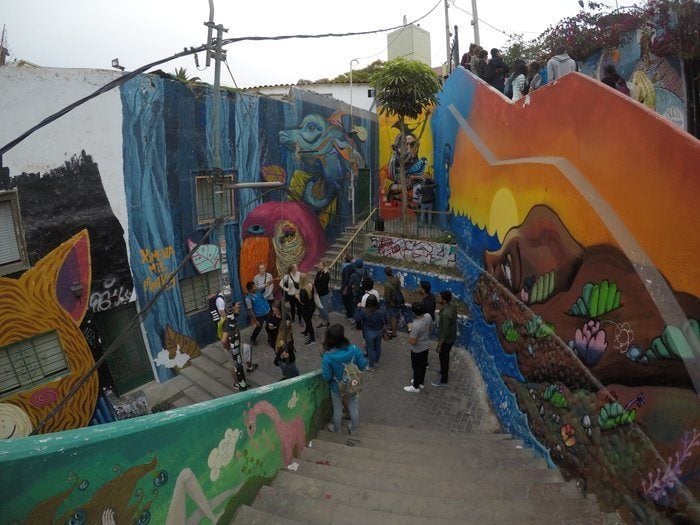
Photo: Sasha Savinov
- Why it’s awesome: Free outdoor art museum with authentic Lima culture away from tourist crowds
- Cost: Free to explore, gallery visits ($3-6)
- Food recommendation: Grab a cortado and pastry at Sofá Café.
Barranco, often called the “Soho of Lima,” is full of delightful surprises – think colourful street art, cosy cafés, and a laid-back bohemian vibe. The neighbourhood’s colonial mansions have been transformed into galleries that beautifully showcase Peru’s contemporary art scene. Start your stroll at the iconic Puente de los Suspiros (Bridge of Sighs) and wander through the charming cobblestone streets. Then, make your way down the Bajada de los Baños, a lovely pedestrian path lined with boutiques, galleries, cafés, bars, and restaurants, that leads all the way to the Pacific Ocean. If you’re into art, you’ll love this open-air gallery where local artists have painted vibrant murals on nearly every corner.
Stop 2: Miraflores Malecón
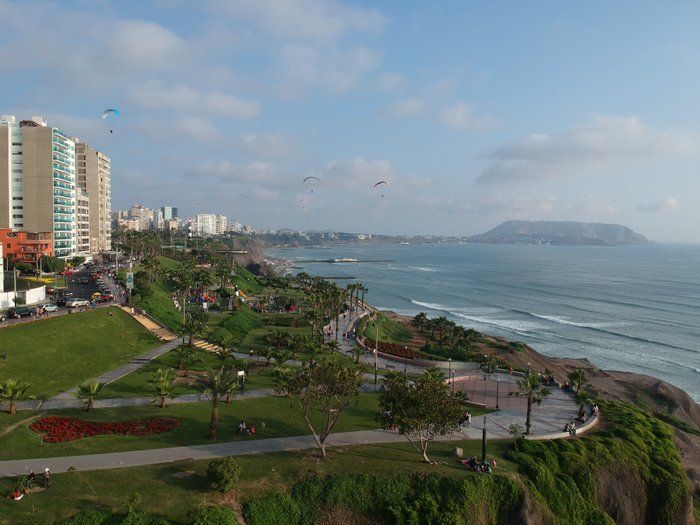
- Why it’s awesome: The Malecon coastal walk has jaw-dropping sunset views over the Pacific.
- Cost: Free to walk
- Food recommendation: Try anticuchos (grilled beef heart skewers) from street vendors for an authentic Lima snack
The Malecón de Miraflores offers some of Lima’s best coastal views without the pricey beach clubs. This clifftop boardwalk stretches for kilometres above the Pacific, perfect for catching stunning sunsets and feeling the cool ocean breeze cutting through Lima’s coastal fog. If you’re lucky, you’ll catch paragliders launching off the cliffs, putting on a surprising aerial show. The nearby streets buzz with locals on their way to work and tourists soaking up Lima’s modern vibe. Street vendors here offer everything from fresh fruit to handmade crafts.
Where to Stay in Lima – Day 1
Antigua Miraflores | Best Budget Hotel

Antigua Miraflores turns a colonial mansion into budget-friendly luxury with cool tilework and chill courtyards. Steps from the Malecón, you get sunset ocean views and easy access to Barranco’s artsy vibe. Authentic charm meets modern perks like hot water and Wi-Fi.
Swissôtel Lima | Best Luxury Hotel
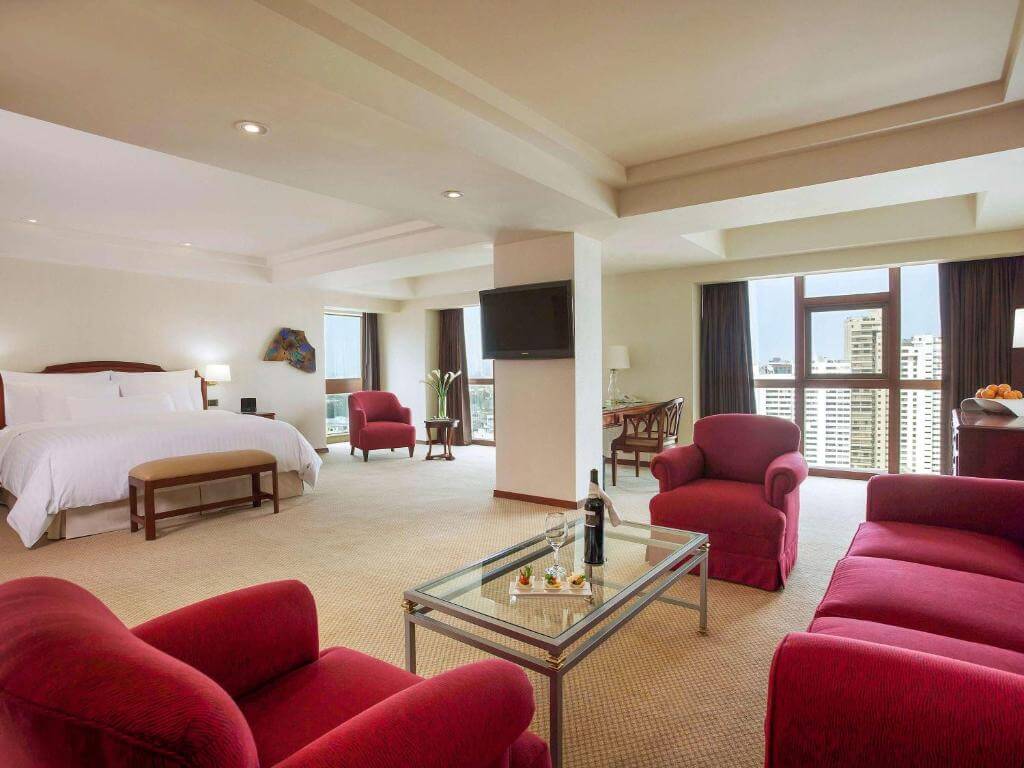
Swissôtel Lima offers five-star vibes in San Isidro’s business hub with killer city views from floor-to-ceiling windows. Relax at the rooftop pool and spa, then dig into Peru’s best cuisine at the onsite restaurants. Executive floors come with club access and free breakfast for a luxe stay.
Pariwana Hostel Lima | Best Hostel
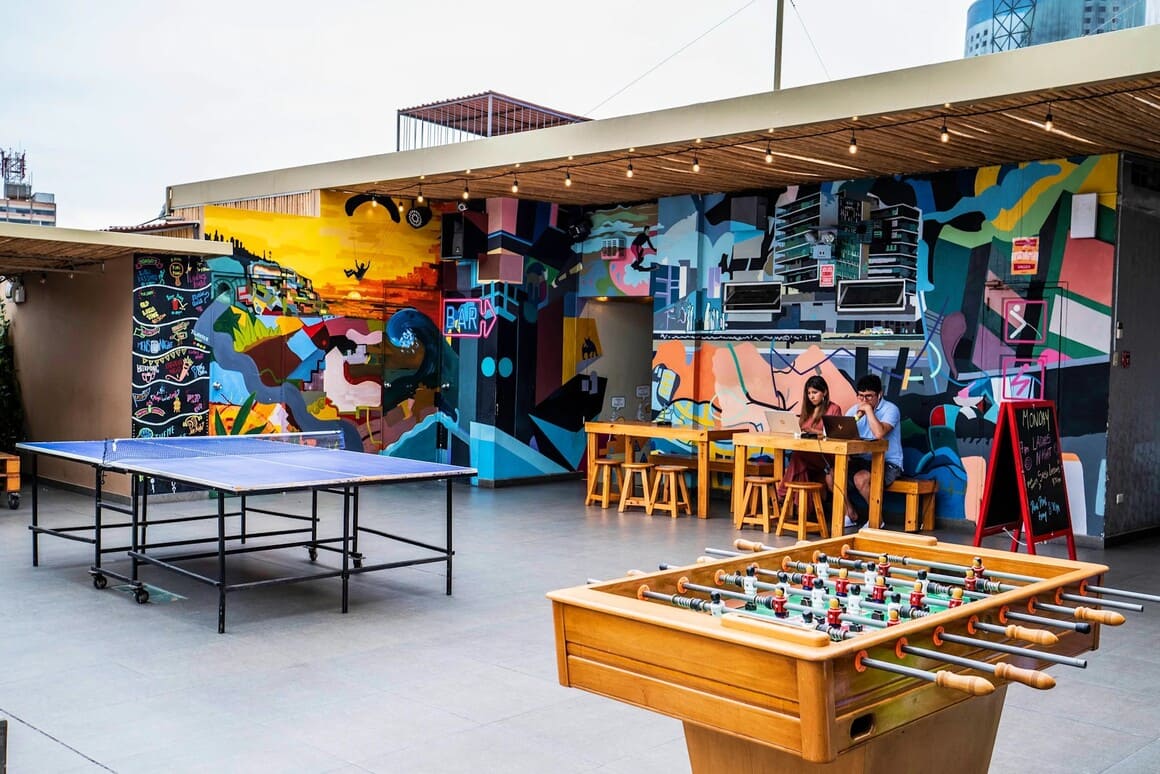
A favourite in Miraflores, Pariwana has rooftop terraces overlooking the Pacific Ocean. The buzzing common areas are perfect for meeting fellow travellers. Kitchen facilities help you save cash, and being close to the Malecón means less transport hassle in Lima’s safest neighbourhood.
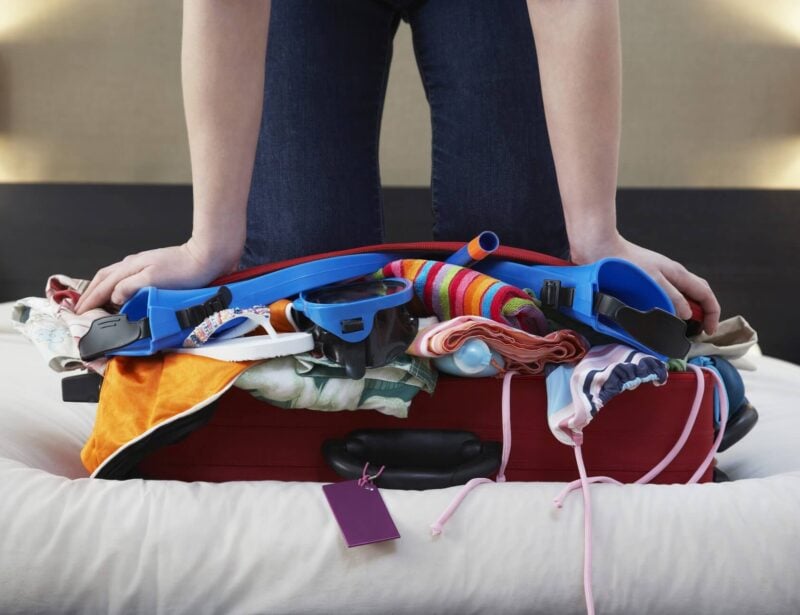
Wanna know how to pack like a pro? Well for a start you need the right gear….
These are packing cubes for the globetrotters and compression sacks for the real adventurers – these babies are a traveller’s best kept secret. They organise yo’ packing and minimise volume too so you can pack MORE.
Or, y’know… you can stick to just chucking it all in your backpack…
Get Yours Here Read Our ReviewDay 2 in Peru: Fly to Cusco
Cusco is stunning, but altitude sickness is real. Take today slowly and acclimate. Wander, hydrate, and soak it all in.
Stop 1: San Blas Artisan District
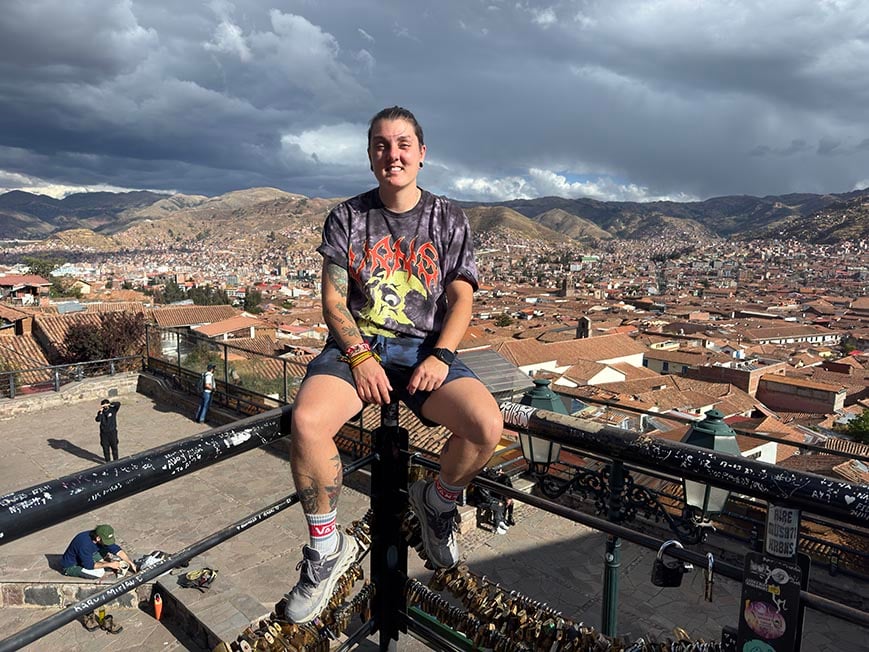
Photo: Nic Hilditch-Short
- Why it’s awesome: Authentic artisan workshops where you can watch craftsmen work using traditional Inca techniques
- Cost: Free to explore.
- Food recommendation: Grab coca tea and quinoa soup at Green Point or L’atelier
San Blas is a hillside neighbourhood full of white walls, blue doors, and winding alleys. It shows a real side of Cusco, famous for its centuries-old craftsmanship. A stroll along the narrow cobblestone streets will lead you to master goldsmiths, painters, and sculptors.
At 3,400 meters altitude, it’s a chill way to ease into Cusco’s height. Stroll down Cuesta San Blas, where artisans display textiles, jewellery, and wood carvings made with traditional skills. On Saturdays, the main square turns into a lively craft fair, full of alpaca garments, local art, and tasty food. Prices are fair and friendly, especially if you can haggle a bit in Spanish. This spot is a must for an authentic, budget-savvy Peru trip.
Stop 2: Qorikancha Temple
- Why it’s awesome: Best-preserved example of Inca stonework.
- Cost: Entry ($5)
- Food recommendation: Try local comfort food like adobo or chicha morada.
Qorikancha is Cusco’s most mind-blowing architectural experience, where flawless Inca stonework meets Spanish colonial buildings. It’s the city’s top Inca archaeological site, now owned by the Catholic Church. The sharp contrast between Inca precision and European construction tells Peru’s colonial story all in one spot.
History buffs will love this tidbit of info – the temple’s original gold-covered walls housed mummies of Inca emperors and other sacred treasures, before Spanish conquistadors looted them all. stripped everything valuable. There are informative panels that explain the history clearly, so you don’t need an expensive guide, but expert guides are available if you want the full story.
Stop 3: San Pedro Market
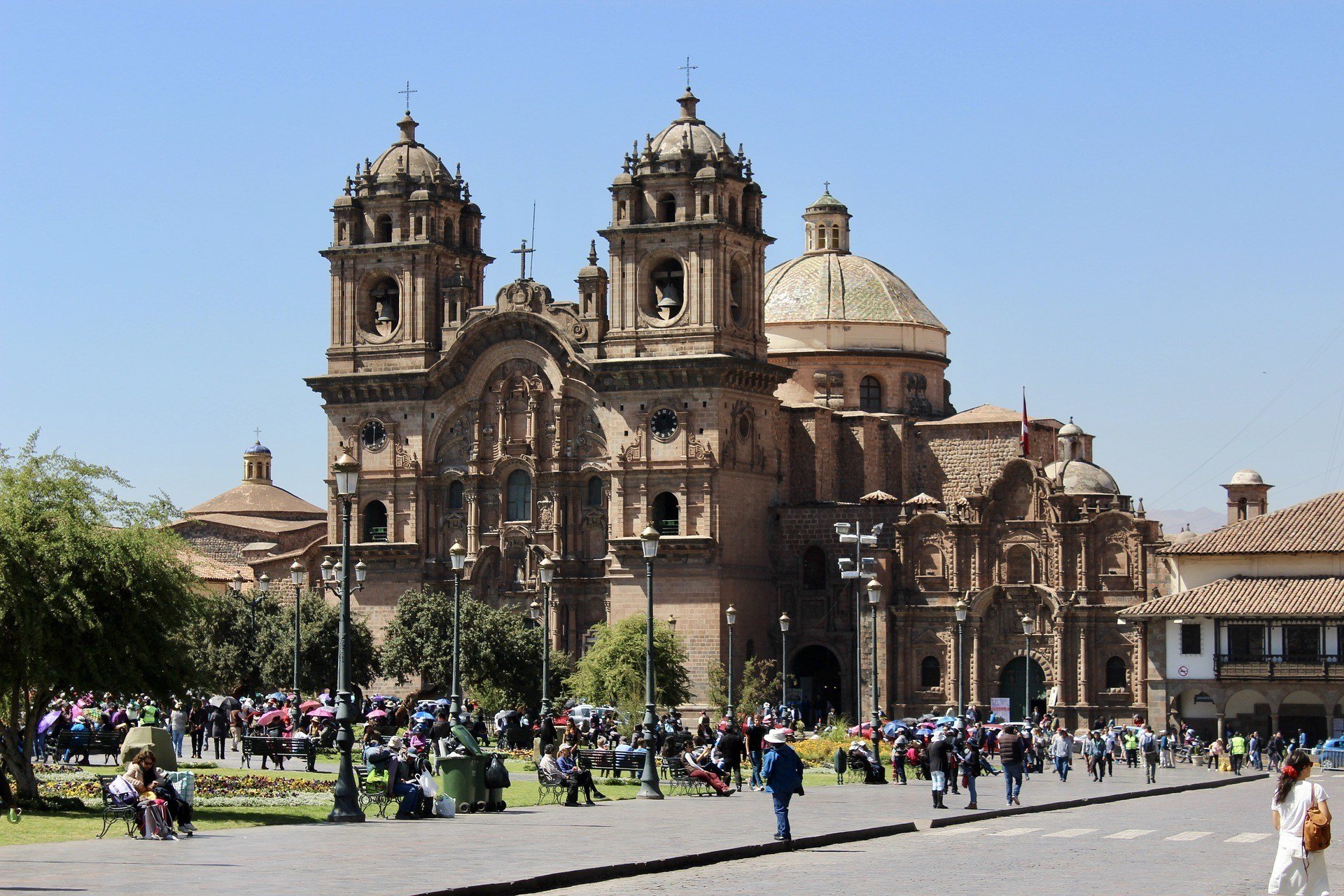
- Why it’s awesome: Real local market experience with exotic Amazonian fruits and traditional foods at local prices
- Cost: Free to enter, $1–3 for juices, empanadas, or woven goods
- Food recommendation: Order rocoto relleno (stuffed peppers) from the market – spicy and filling, yum!
San Pedro Market is the city’s main spot for fresh produce, traditional medicine, and local eats that tourists often miss. So, expect a sensory overload: exotic Amazonian fruits, dozens of potato varieties, and the sharp scent of local cheeses. Vendors will call out prices in Quechua, adding to the authentic buzz.
Wander through the market’s small food stalls, where they serve big plates of traditional dishes. This is where local families do their weekly shopping, giving you a genuine cultural experience far from the tourist traps. San Pedro is perfect for anyone wanting to see Cusco beyond the usual sights.
Where to Stay in Cusco – Day 2
Apu Huascaran Hostal | Best Budget Hotel
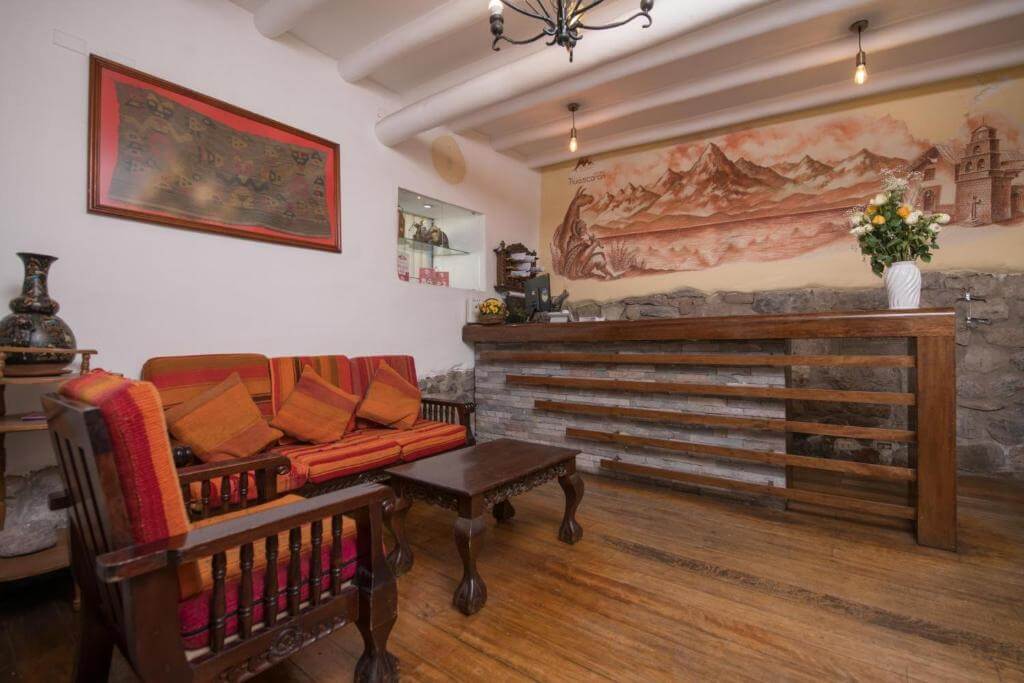
Apu Huascaran Hostal blends colonial architecture with Cusco charm. The hotel serves coca tea to ease your altitude adjustment, while you relax in its cosy, centrally heated rooms. Just a few steps away from the San Blas neighbourhood, this hotel also offers easy access to Cusco’s main attractions and is the perfect base for the city.
JW Marriott El Convento Cusco | Best Luxury Hotel

Set in a 16th-century convent, JW Marriott offers luxurious accommodation with oxygen-enriched rooms and a world-class spa. The central courtyard preserves original colonial architecture while modern amenities include heating and gourmet dining. Its prime San Blas location means you’re close to the Qorikancha temple and artisan workshops.
Wild Rover Cusco | Best Hostel
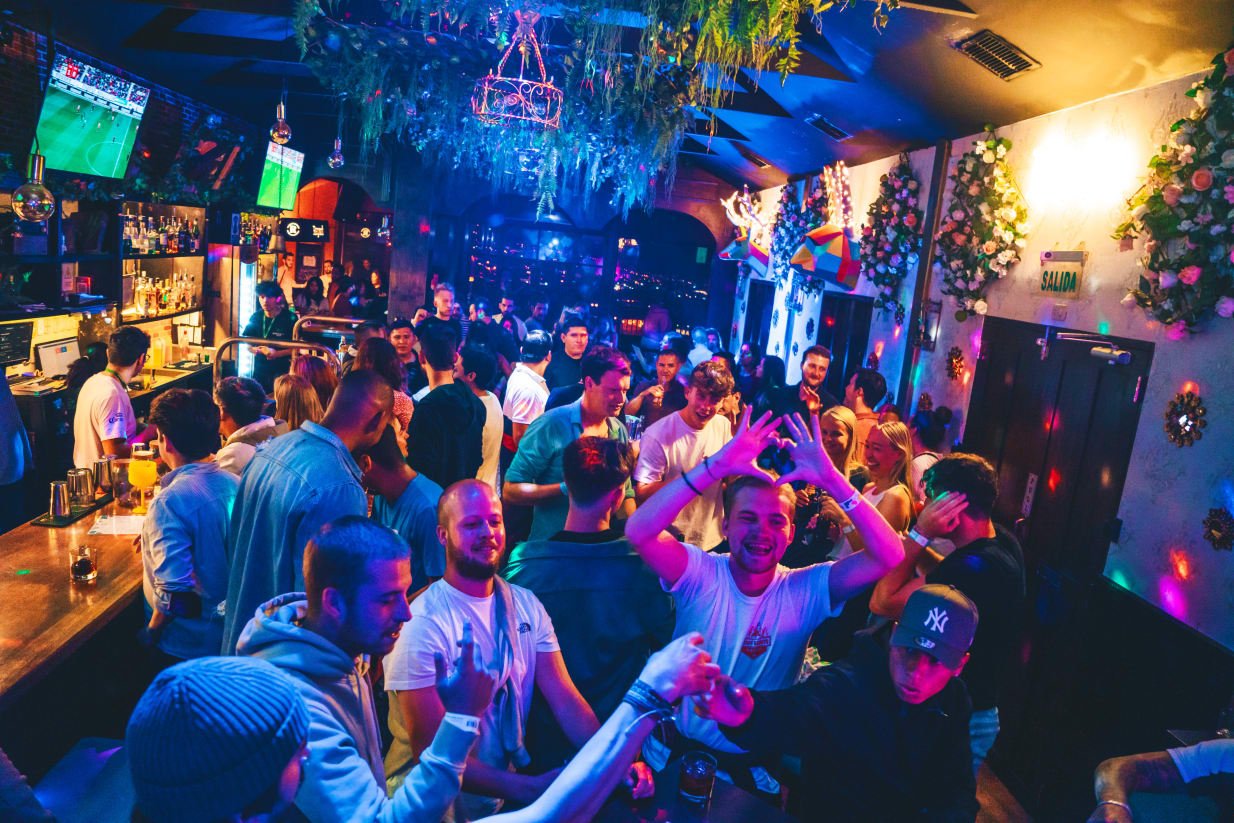
Wild Rover Cusco rules the party scene with oxygen-enriched dorms (to combat altitude sickness) and a rooftop bar. Located in the historic centre, it offers 24-hour hot water, Wi-Fi, and easy access to major attractions.
Day 3 in Peru: Sacred Valley
They say, Sacred Valley is your deep breath between Cusco and Machu Picchu. Ancient sites and surreal landscapes, all wrapped in one unforgettable day – here’s where the fun starts!
Stop 1: Pisac Ruins + Market
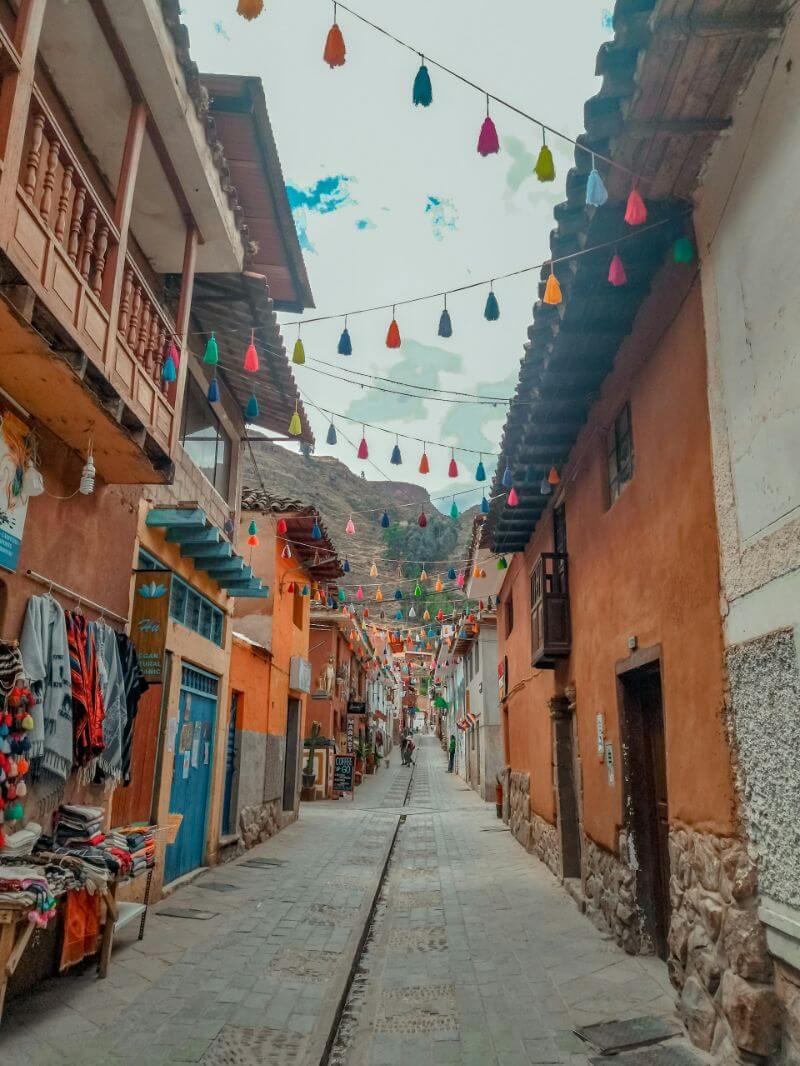
- Why it’s awesome: Less crowded than other Sacred Valley sites, but with equally epic Inca terraces and mountain views
- Cost: Included in the Boleto Turístico (Cusco) (sightseeing ticket for tourists covering a number of sites), approx. $20-25
- Food recommendation: Try cuy chactado (fried guinea pig) at local restaurants. It’s Peru’s most traditional protein!
Pisac is a great escape from Cusco’s crowds, with some of the Sacred Valley’s best Inca ruins. Perched on a mountainside, its terraced farms showcase Inca engineering at its finest. Unlike busy Ollantaytambo, Pisac lets you explore temples and homes without crowds or photo struggles.
The town’s colourful market runs daily from 9 am to 4:30 pm, but if you want to experience something out of the ordinary, go on a Sunday. That’s when Quechua locals arrive in traditional dress and turn the main square into a vibrant cultural showcase. At the market, you will find a variety of stuff, from touristy alpaca sweaters to genuine local produce and rare Andean potatoes you won’t find elsewhere.
Stop 2: Chinchero Traditional Weaving
- Why it’s awesome: A living museum of Andean culture with hands-on, live demos.
- Cost: Entrance to the ruins is included in the tourist ticket. Weaving demonstrations are free.
- Food recommendation: Sample chicha de jora (fermented corn beer), an ancient Inca beverage.
Sitting at 3762 meters above sea level, the town of Chinchero is one of the highest points in the Sacred Valley. Topped with breathtaking panoramic views of mountains, the village is a must-see stop on your trip to Peru. Chinchero offers an authentic look into Peruvian textiles with weaving demos that date back to Inca times. Local cooperatives will show you the entire process, from sheep shearing to natural dyeing using cochineal insects and plants – it’s fascinating! These genuine demos are led by master weavers sharing traditions passed down for generations. On Sundays, the market comes alive with locals from nearby communities dressed in traditional clothing.
Stop 3 (Alternate option): Moray & Maras Salt Mines
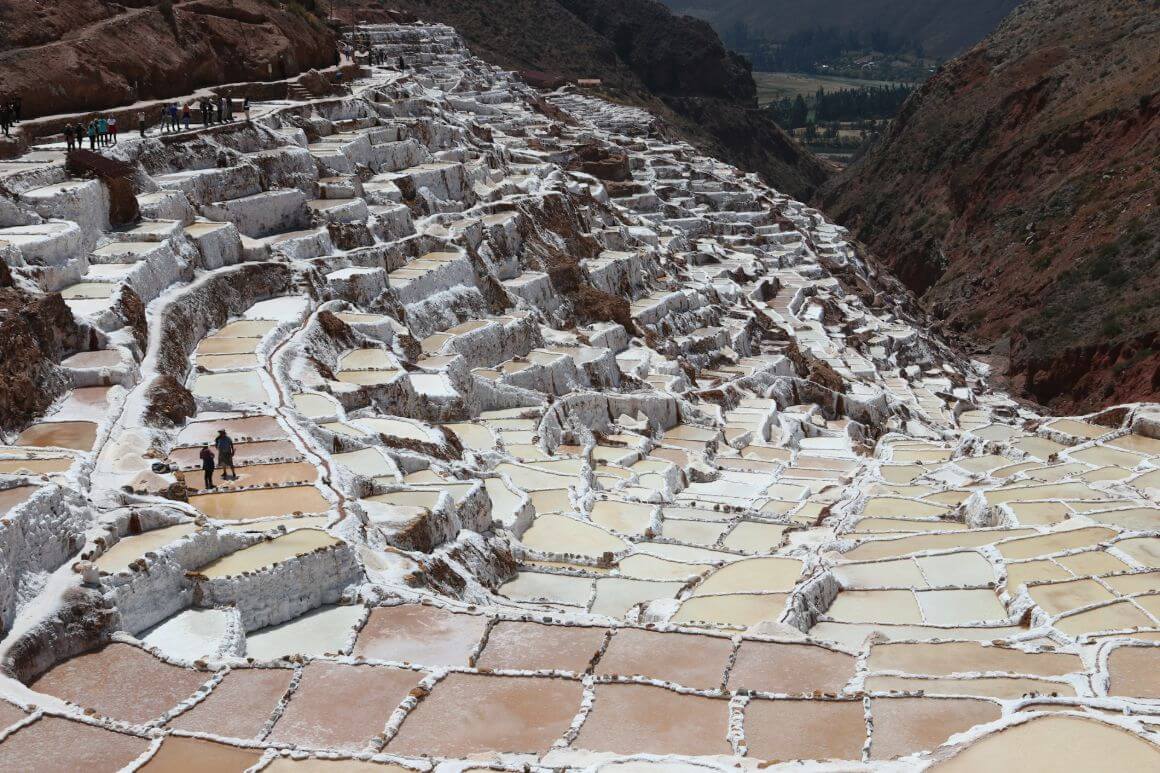
- Why it’s awesome: Surreal geometric terraces and ancient salt harvesting.
- Cost: Moray is included in the tourist ticket. Maras salt mines ($4.50) extra.
- Food recommendation: Salt-chocolate at Maras. You won’t regret it.
So, you want something weirder? Swap Chinchero for Moray’s crop-circle terraces and the white salt flats of Maras.
Moray offers a surreal archaeological experience -circular terraces forming a giant amphitheatre. History says the Incas tested crops here, experimenting with microclimates and creating temperature shifts. The site feels otherworldly, especially if you visit during golden hour and catch stunning shadows that highlight its perfect geometry.
The Maras salt mines are nearby, displaying thousands of salt ponds creating a striking white and pink patchwork against lush green valleys. Local families have harvested salt here for over 500 years, using age-old methods still alive today.
Tip: Hire a taxi for the day or join a group tour.
Where to Stay in Sacred Valley – Day 3
Tunupa Lodge | Best Budget Hotel
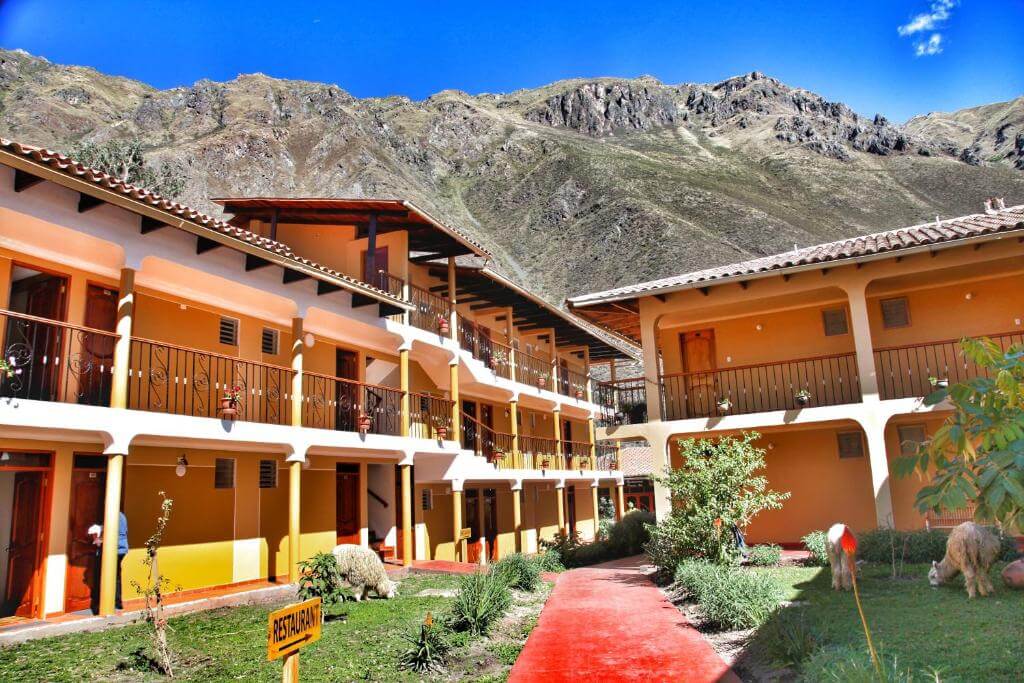
Tunupa Lodge is a good budget hotel that offers cosy rooms with traditional textiles in the peaceful town of Ollantaytambo. Located in the peaceful town of Ollantaytambo, you’ll experience authentic Andean village life while staying close to the train station for Machu Picchu. The onsite restaurant serves delicious local dishes made from organic garden ingredients.
Tambo del Inka Resort | Best Luxury Hotel
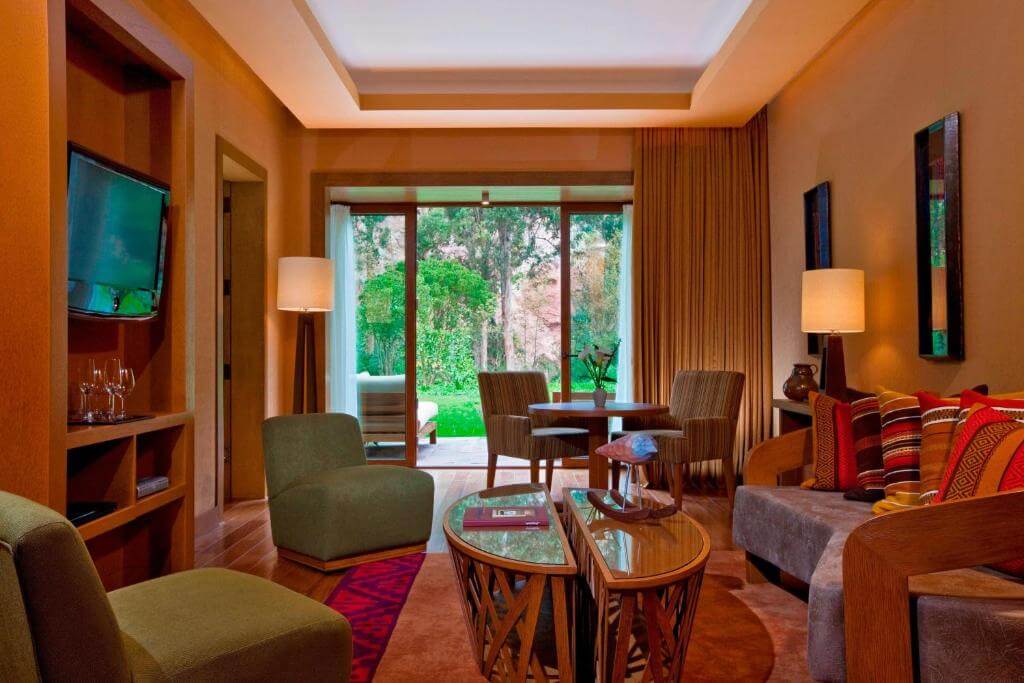
The Tambo del Inka Resort is a full-on luxury experience right in the town of Ollantaytambo, next to its train station. Here you can immerse yourself for a day of relaxing with spa treatments that use Andean traditions. The resort offers gourmet dining with local produce and private terraces with mountain views. The adventure centre organises unique cultural experiences with Quechua communities nearby.
El Parche Rutero Hostel | Best Hostel
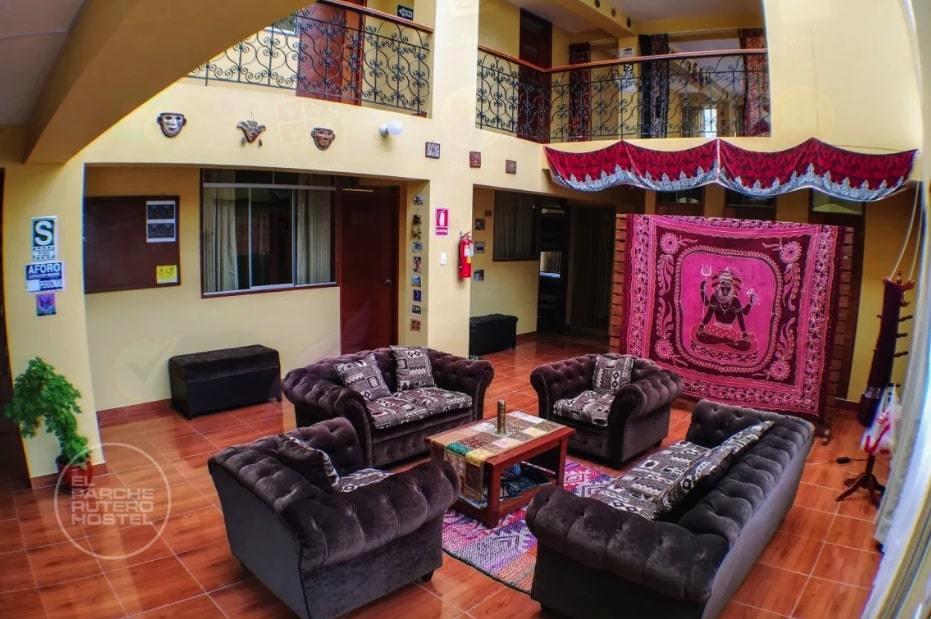
El Parche Rutero Hostel sits in the heart of Pisac with mountain views from the terrace. You can walk to the ruins and the market. The communal kitchen allows you to keep within budget and also lets you meet fellow backpackers. Hot showers and reliable Wi-Fi make it a comfy base for Sacred Valley adventures.
Day 4 in Peru: Ollantaytambo
Ollantaytambo isn’t just a stopover; it’s one of the last living Inca towns. It’s a magical place to visit that pretty much exemplifies why most want to come to Peru in the first place.
Stop 1: Ollantaytambo Ruins
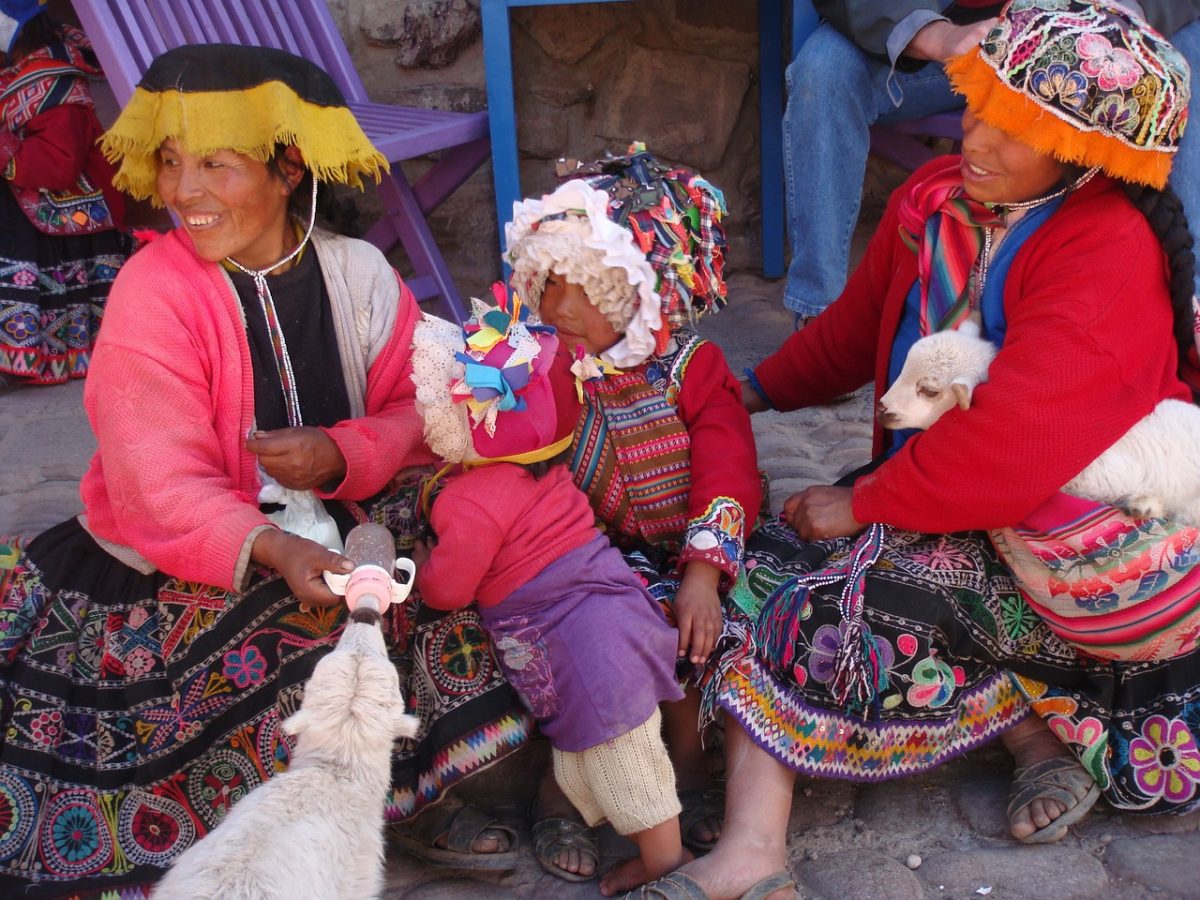
- Why it’s awesome: The only living Inca city where locals still inhabit original buildings, plus the site of the greatest Inca victory over Spanish forces
- Cost: Included in the Boleto Turístico (Cusco) (sightseeing ticket for tourists covering a number of sites), approx. $20-25
- Food recommendation: Try fresh trout from local streams, perfectly grilled with Andean herbs at Killa Wasi restaurant
Ollantaytambo is one of the Sacred Valley’s most captivating sites, and a must-see for every history and culture enthusiast. It is a living Inca city and fortress with impressive stone terraces and temples used for astronomy. It’s famously where the Spanish conquistadors faced a rare defeat. The massive stone walls rise dramatically from the town centre, showcasing expert Inca urban planning and stone masonry. Some blocks weigh up to 50 tons and were hauled from distant quarries.
Unlike many ruins, Ollantaytambo still feels alive, with local families living in original Inca buildings along narrow cobblestone streets. This mix of history and daily life creates a unique experience, blending the ancient and the modern in one of South America’s most impressive archaeological sites.
Activity: Evening Train to Aguas Calientes
We recommend taking the evening train from Ollantaytambo to Aguas Calientes, so you are refreshed and ready for your early morning Machu Picchu visit and trek. The train takes about 1 hour 45 minutes, passing through stunning Sacred Valley landscapes that blend Inca and colonial influences. PeruRail and Inca Rail run multiple daily trains catering to all budgets and comfort levels. The route follows the Urubamba River through cloud forests, shifting from high-altitude valleys to lush subtropical vegetation.
Tip: It’s best to book your tickets early, especially for peak season (May-September), as trains fill fast.
Where to Stay in Ollantaytambo – Day 4
Ccapac Inka Ollanta Boutique Hotel | Best Budget Hotel
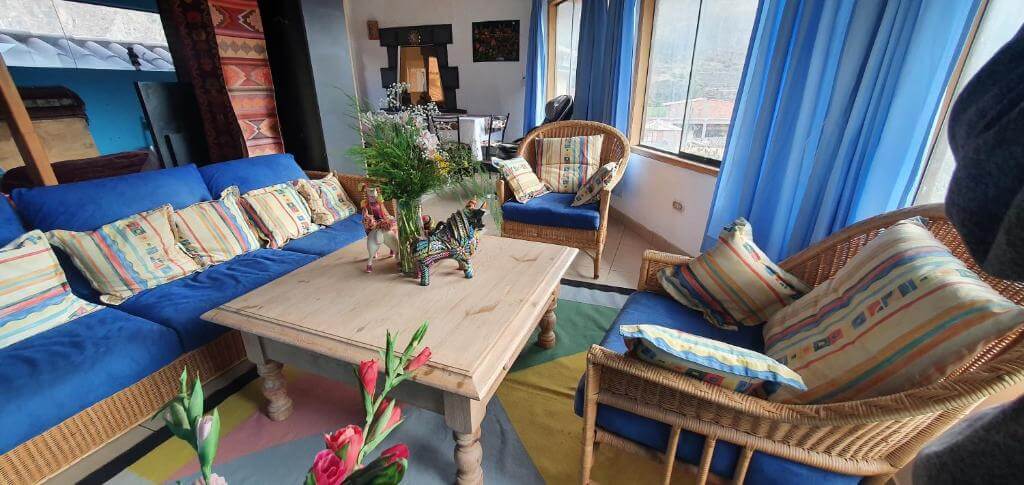
Located in the historic centre, Ccapac Inka Hotel combines traditional Andean style architecture with modern comfort. Cosy colonial rooms with heating and local textiles offer charm and warmth. The quiet courtyard is perfect for relaxing after exploring ruins and village life nearby.
El Albergue Ollantaytambo | Best Luxury Hotel
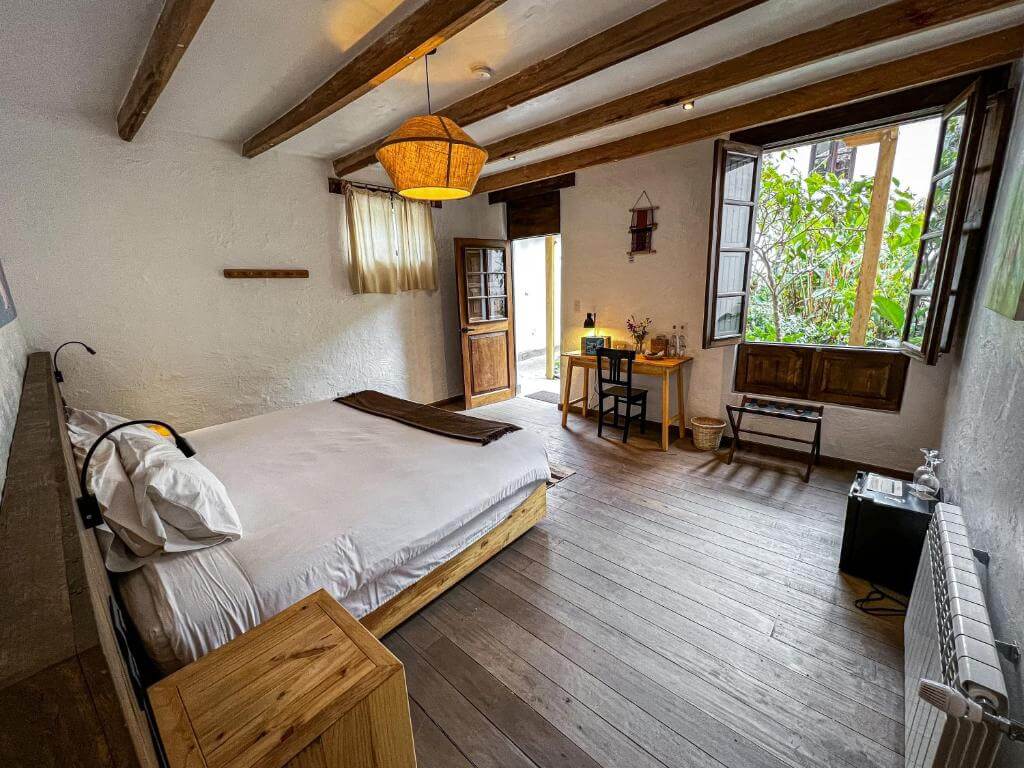
A railway station converted into a boutique accommodation, El Albergue is a fine luxury hotel. Rustic-chic rooms showcase mountain views and sustainable design. Its organic, farm-to-table restaurant is award-winning, making it perfect for eco-conscious Machu Picchu travellers seeking comfort and convenience.
Mountain View House Ollantaytambo | Best Hostel
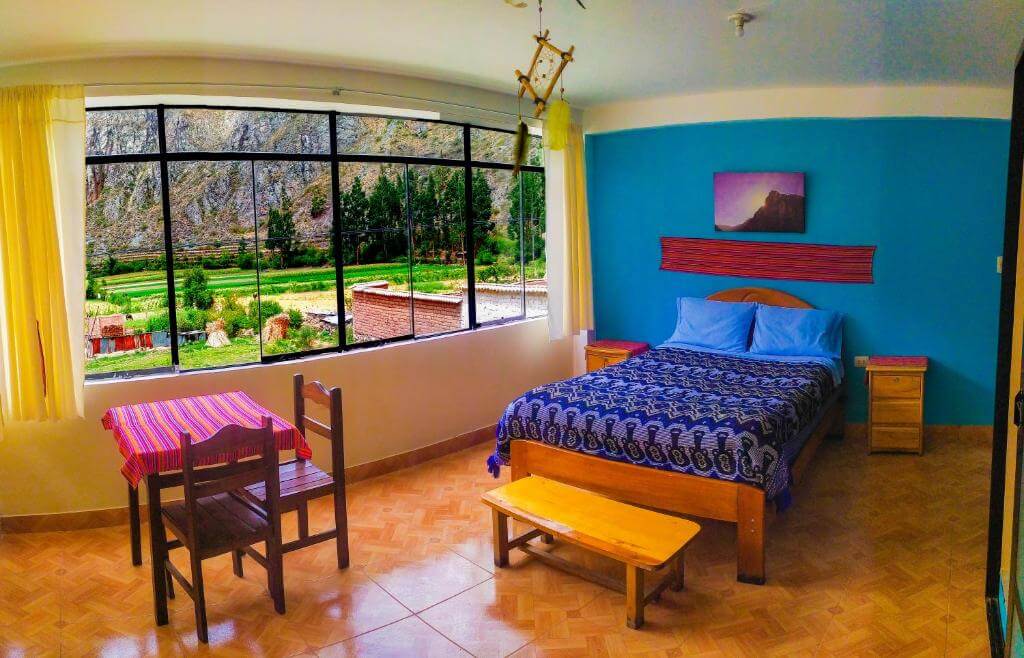
Mountain View House hostel offers epic Andes views from its rooftop terrace. It is within walking distance to both the ruins and the train station. As with hostels, there is a shared kitchen, while common areas are lively with fellow travellers sharing and swapping Machu Picchu trek tips. Hot showers and reliable Wi-Fi keep you comfy.
Day 5 in Peru: Aguas Calientes (Machu Picchu)
The day you’ve been waiting for. Wake up early and catch the first bus or start hiking – either way, aim to arrive before the crowds.
Stop 1: Early Morning Machu Picchu Entry
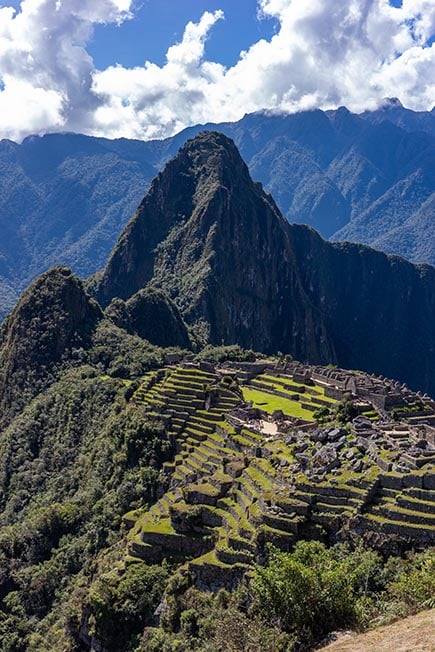
Photo: Nic Hilditch-Short
- Why it’s awesome: The entire scene is magical – mist curling off the stone walls, llamas roaming freely.
- Cost: Entry tickets cost around $45 for adults, plus $12 for the shuttle bus (book well in advance online).
- Food recommendation: Pack snacks from Aguas Calientes, as no food is sold inside the ruins.
Set your alarm for 4:30 AM. We’re talking about going to see one of the wonders of the world, so we can wake up before the birds start singing. The first shuttle from Aguas Calientes will leave at 5:30 AM, taking you up the twisty mountain road to Machu Picchu. Arriving early means fewer crowds and catching the dreamy morning light, casting a magical glow over the ancient citadel. Keep your cameras out – this will be super Insta-worthy!
The moment you walk through the entrance and catch your first glimpse of Machu Picchu, prepare for goosebumps. There’s your ‘wow’ moment. The terraces will seem to drop off the mountainside, often wrapped in mist around the Huayna Picchu peak, making it feel like a dream. Just make sure you pack your waterproofs as the weather here is famously unpredictable!
Spend your first hour soaking it all in – the incredible stonework and the view over the Urubamba River valley. The fact that this city was built 2,430 meters up will blow your mind. Snap the classic panoramic shot, but don’t miss exploring the detailed residential and ceremonial areas – it’s a full-on Inca adventure.
Stop 2: Huayna Picchu or Inti Punku (Sun Gate) (Optional)
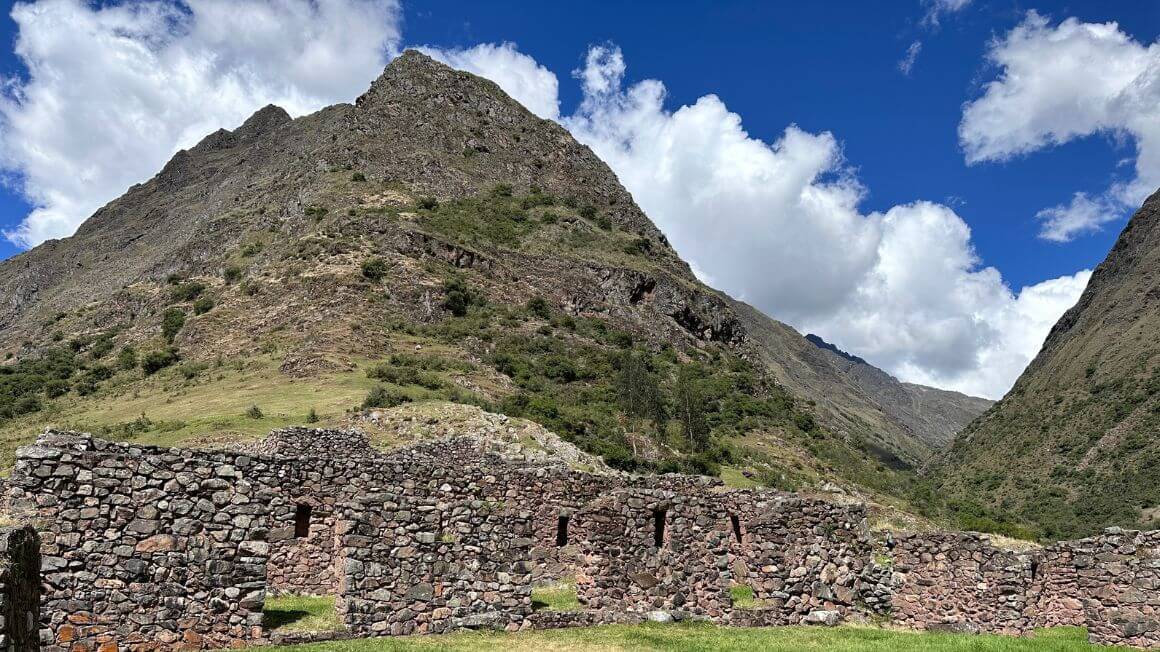
Photo: @willhatton__
- Why it’s awesome: You get panoramic views of Machu Picchu and quieter trails
- Cost: Additional $15-20 if you add Huayna Picchu to your Machu Picchu ticket. Sun Gate is usually included in the Machu Picchu ticket (depending on the circuit).
- Food recommendation: Bring energy bars and plenty of water. Both hikes are physically demanding at altitude.
Up for more stairs and greater views? If you’re a true adventure-seeker, try to tackle one of these two hiking options. Huayna Picchu is the towering peak you see in every Machu Picchu photo. It’s a challenging & steep hike up, around a hundred steps (45 – 60 min), but totally worth it, it’s one of the best hikes in the world! The birds-eye views of the ruins below are epic!
Alternatively, the Sun Gate (Inti Punku) is a moderate 1.5-hour round-trip hike along the original Inca Trail route. This stone gateway used to be the dramatic entrance for Inca royalty arriving from Cusco. The views back toward Machu Picchu are phenomenal, especially with fewer crowds than Huayna Picchu.
Tip: Book your tickets early, as soon as you secure your Machu Picchu ticket. Both hikes need separate permits and limit access to 400 people daily.
Activity: Evening Return Journey to Cusco
Done with your awesome Machu Picchu adventure? Your next stop in this 7-day Peru itinerary is back to base in Cusco. Hop on the evening train from Aguas Calientes and take the scenic ride through the Sacred Valley. Book a window seat and keep your camera ready for the stunning mountain scenes and captivating sunset shots reflecting off the Urubamba River.
Where to Stay Near Machu Picchu – Day 5
Inti Llaqta Hotel | Best Budget Hotel
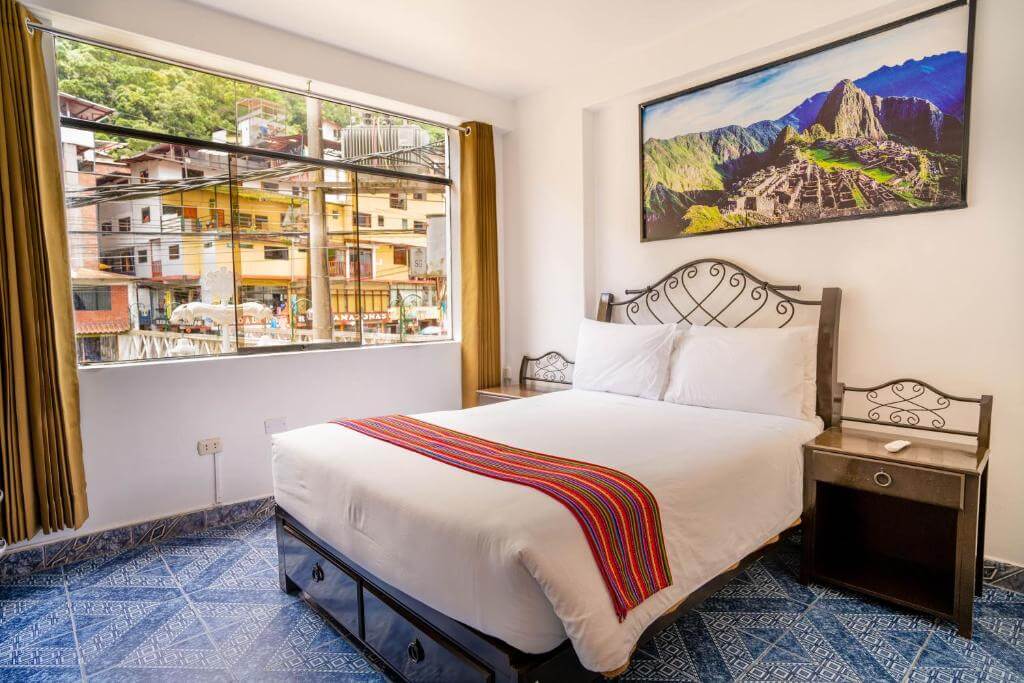
Inti Llaqta is family-run and delivers excellent value with comfortable private rooms, reliable Wi-Fi, and helpful staff who arrange early morning shuttle reservations. Breakfast is included and provides the perfect fuel for your pre-dawn Machu Picchu adventure, while the central location keeps you close to Aguas Calientes’ best local eateries.
Machu Picchu Sanctuary Lodge | Best Luxury Hotel
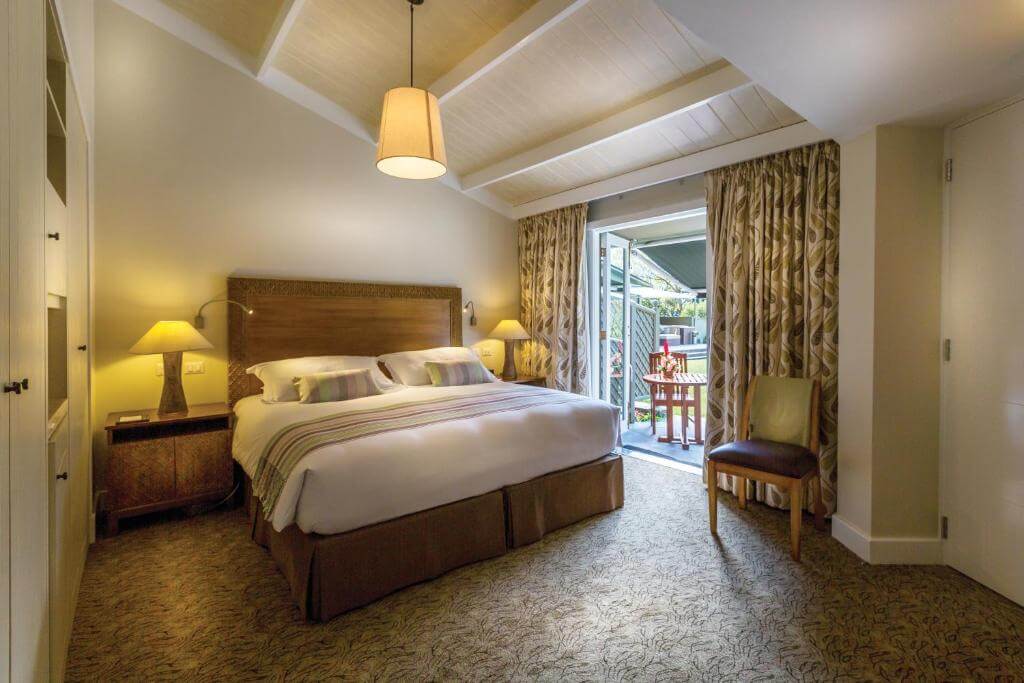
The only hotel located directly at Machu Picchu’s entrance gates, this one offers unparalleled access and luxury amenities. This lodge gives you the perfect luxury experience when you wake up to sunrise views of the citadel from your room and enjoy gourmet Peruvian cuisine.
Supertramp Hostel | Best Hostel

One of our top fav hostels and backpacker favourites, this hostel offers spotless dorms, hot showers and a friendly vibe for making new friends and sharing adventure stories with fellow travellers. It is minutes away from the shuttle bus pickup point and has good Peruvian comfort food options nearby.
Arriving back in Cusco around nighttime, you will be exhausted but exhilarated. This is why we have fit in a day of relaxing and exploring Cusco. When you arrive back in Cusco at night, celebrate your previous days’ hikes with a pisco sour at one of Cusco’s rooftop bars.
The next day, on day 6 of this itinerary for Peru, we head out in the city to explore these hidden gems that we found for you.
Stop/Activity 1: Temple of the Moon (Qolqabamba) Hike
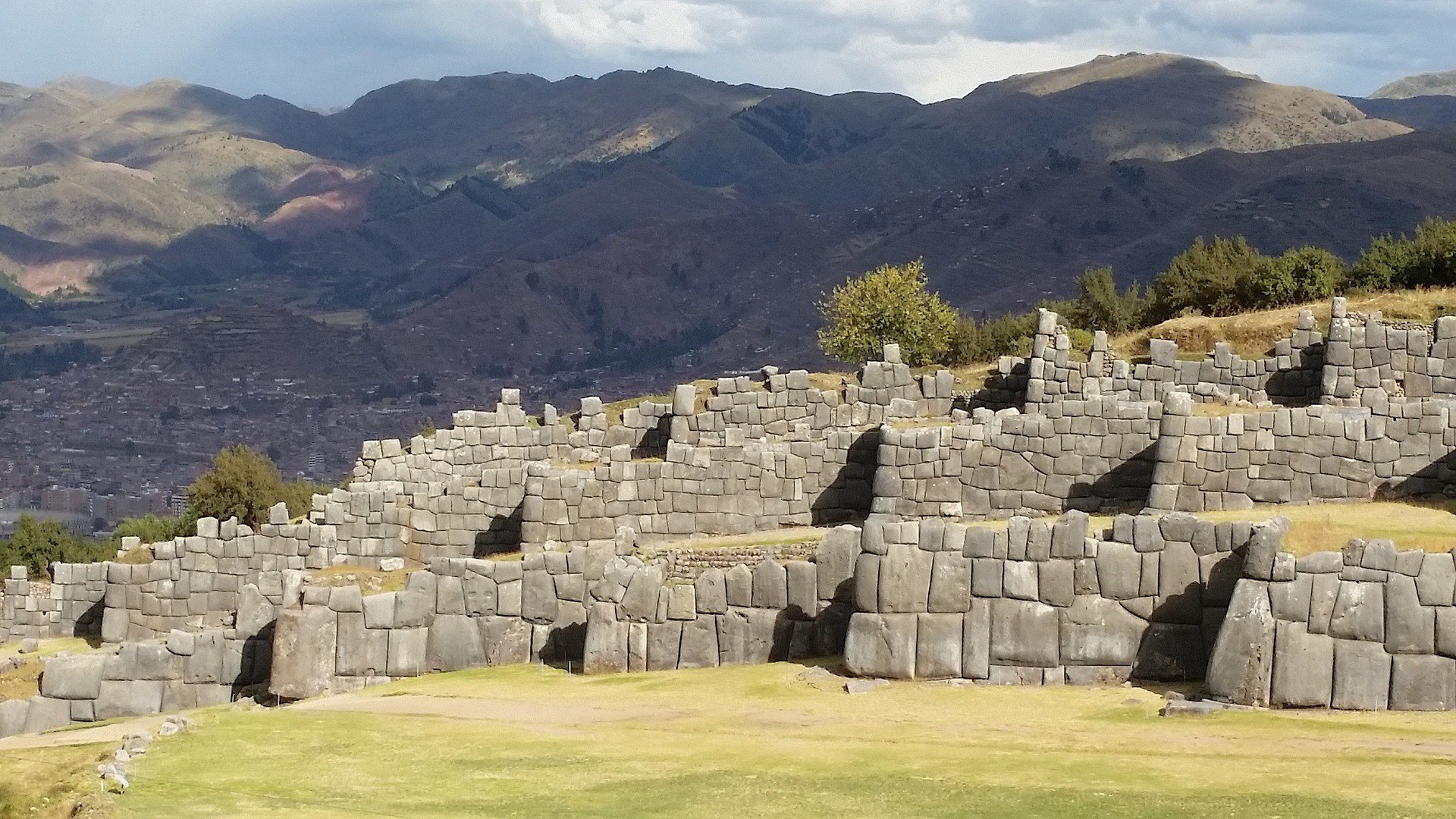
- Why it’s awesome: Hidden Inca altars, sacred caves, and stunning valley views over Cusco.
- Cost: Free entry.
- Food recommendation: Pack snacks from San Pedro Market – try fresh bread rolls filled with local cheese and coca tea.
Skip the crowds and discover this hidden Inca treasure just 30 minutes from Cusco’s San Blas neighbourhood. The hike to the Temple of the Moon is short, sweet, and seriously underrated. This sacred site is carved into a natural cave, featuring perfect stonework, ceremonial altars, and mysterious niches, probably used for rituals.
The hike is around an hour each way, moderate and with calming views of Cusco’s red-tiled rooftops and surrounding peaks. Most travellers never discover this gem, and we don’t want you to miss it. The trail runs through eucalyptus forests and traditional Quechua communities, and since there are fewer crowds, you get loads of photo-ops.
Tip: Pack layers, as this hike is at 3600m, where the air is thin and the weather can shift quickly.
Stop/Activity 2: Museo de Arte Precolombino & Local Coffee Culture
- Why it’s awesome: Gain deep cultural understanding through world-class artefacts while supporting ethical local businesses and artisan communities.
- Cost: Museum entry $4-6, coffee tastings $5-8
- Food recommendation: Try traditional api (purple corn drink) and tanta wawa (bread babies) at local bakeries near the museum.
This one’s for the culture and history buffs. Make a trip to the Museo de Arte Precolombino, a world-class museum tucked inside a beautifully restored colonial mansion in Cusco. The museum curates a collection that spans 3000 years of Peru’s pre-Columbian heritage, which includes Moche pottery and Inca gold work. Unlike other museums, here you can study masterpieces up close.
Next up, check out the local coffee culture at roasteries serving up some high-altitude Peruvian beans. Coffee lovers should really try this. Spots like Café Ayllu and Museo del Café offer roasting demos and cupping sessions, and you also get the chance to chat with local baristas about sustainable practices.
Stop/Activity 3: Live Andean Music & Ethical Chocolate Workshop
- Why it’s awesome: Authentic cultural immersion supporting local artists while learning traditional skills
- Cost: Workshops starting from $10 with take-home creations.
- Food recommendation: Enjoy anticuchos (grilled beef heart skewers) and chicha morada at traditional peñas for the full local experience.
Head over to a peña (folk music venue) in San Blas, where local musicians play traditional Andean tunes on charangos, quenas, and zampoñas. Places like this are the real deal because you get to immerse yourself in an authentic cultural experience.
Not into music? It’s okay! Join a fun chocolate-making workshop instead. Peru’s native cacao is some of the best in the world, and these hands-on classes will let you create your own organic treats (and take them home, too). Many workshops work directly with indigenous growers, so you also learn about sustainable farming initiatives.
Where to Stay in Cusco – Day 6
It’s more convenient if you book the same accommodations in Cusco from Day 2 – just book them for Day 6 at the same time. To review, we’ll just list down the places here in Cusco:
Day 7 in Peru: Lima
Your final day in this Peru itinerary begins with an early morning flight from Cusco back to Lima. Depending on your flight time, you’ve either got a quick taste of Lima left or a mad rush to the airport.
Stop/Option 1: Surquillo Market

Photo: @amandaadraper
- Why it’s awesome: Score some unique souvenirs (at local prices) to take home.
- Cost: Market entry is free. Budget $20-50 for souvenirs.
- Food recommendation: Try exotic fruits like lucuma or cherimoya, plus grab empanadas from market vendors.
If you’ve got a few hours to spare, drop your bags at Lima airport’s convenient luggage storage and head over to Surquillo Market. This is Lima’s most authentic local market, and just a short drive away. Surquillo has an incredible variety of stuff, from tropical fruits to handwoven textiles and local spices at a fraction of tourist district prices. It is the perfect last-minute stop for souvenirs. Alpaca scarves, painted ceramics, and freshly packed Peruvian coffee beans – yes, you’ve got to get them all!
Give yourself at least two hours to wander, explore and haggle with vendors who, if you’re lucky, will offer better deals and warmer smiles than others.
Tip: Set a departure alarm, because honestly, you’ll easily get lost in the place and lose track of time.
10-Day Itinerary in Peru
Day 1: Lima | Day 2: Arequipa | Day 3: Colca Canyon | Day 4: Cusco | Day 5: Sacred Valley | Day 6: Aguas Calientes | Day 7: Rainbow Mountain | Day 8 & 9: Puerto Maldonado | Day 10: Return to Lima
The 7-day Peru itinerary covers the essentials from Lima to Machu Picchu. To make it more exciting, we will add 3 more days to the mix and dive deeper. The 10-day Peru itinerary will give you additional Peru attractions – landscapes, colourful mountains and jungles. So, are you ready to level up your Peru trip? Let’s go!
To make things easier to follow, we will touch briefly upon the stops already covered. We will talk in detail about the additional days and stops we will make in this 10-day itinerary. Your trip to Peru will start from Lima, as before.
Day 1 in Peru: Lima
We’ve covered Lima in detail above, so let’s just mention the main stops again – Barranco and Miraflores.
Stop 1: Barranco District
- Why it’s awesome: Free outdoor art museum with authentic Lima culture away from tourist crowds. It’s also the perfect base in Lima if you’re after a more chilled vibe.
- Cost: Free to explore, gallery visits ($3-6)
- Food recommendation: Grab a cortado and pastry at Sofá Café.
Stop 2: Miraflores Malecón
- Why it’s awesome: The Malecon coastal walk has jaw-dropping sunset views over the Pacific.
- Cost: Free to walk
- Food recommendation: Try anticuchos (grilled beef heart skewers) from street vendors for an authentic Lima snack
Where to Stay in Lima – Day 1
Day 2 in Peru: Arequipa
Arquipa is a short domestic flight away from Lima. The city is nicknamed ‘The White City’ for its buildings that are carved from pale volcanic stone.
Stop 1: Plaza de Armas
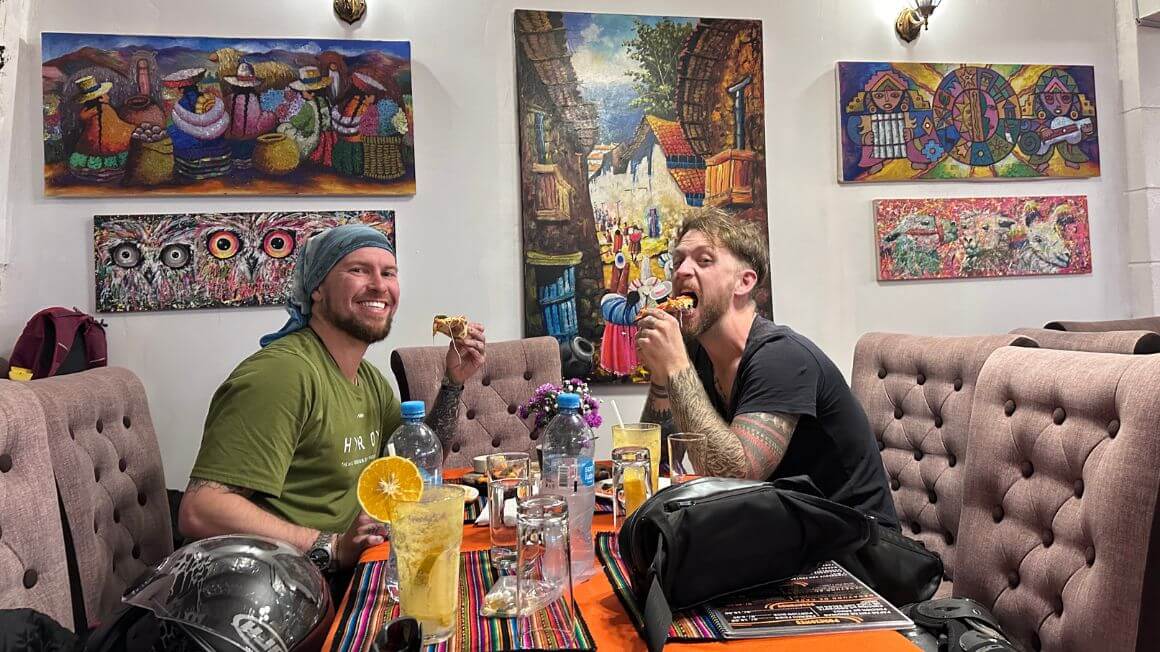
Photo: @willhatton__
- Why it’s awesome: It is Peru’s most beautiful colonial plaza with white volcanic stone architecture, standing against a volcano backdrop.
- Cost: Free to explore.
- Food recommendation: Try queso helado, Arequipa’s signature frozen dessert made with cinnamon and vanilla, from plaza vendors.
Arequipa’s Plaza de Armas is a stunning central square, with gleaming white buildings made from volcanic stone. The massive cathedral stretches across the entire north side, framed by twin towers that have survived centuries of earthquakes. The surrounding arcades house cafés, shops, and municipal offices, all in historic buildings dating to the 16th century.
When you explore Arequipa, it feels lived-in and local. Families gather for evening strolls, vendors sell queso helado (a sweet frozen treat), and musicians fill the air. Sunset views are great in the plaza. The white volcanic stone glows golden, with the silhouette of the majestic El Misti volcano looming in the background. It’s time to grab your cameras! Photographers swear by the blue hour, when the illuminated cathedral lights up against a twilight sky.
Stop 2: Santa Catalina Monastery
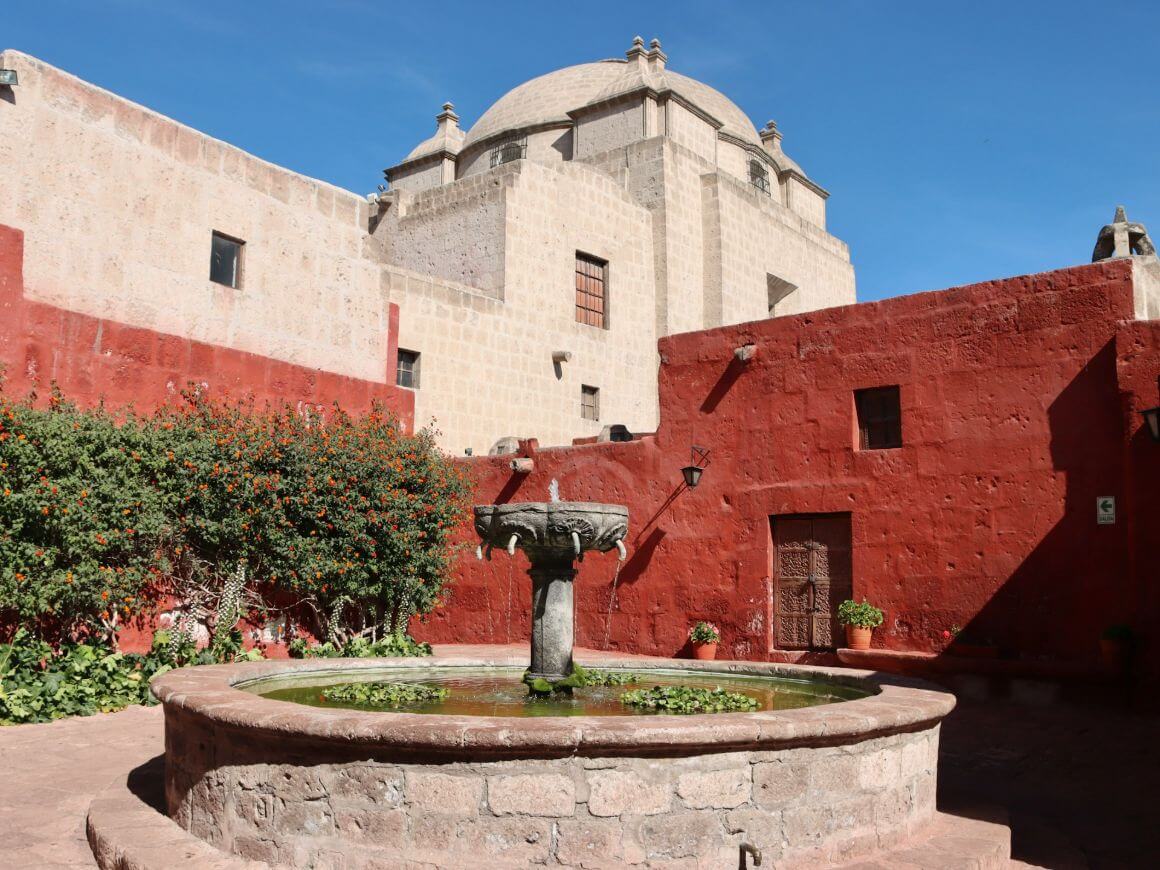
- It’s awesome: It is a perfectly preserved colonial city-within-a-city that remained hidden from the public for 400 years.
- Cost: The Monastery entrance fee is around $13.
- Food recommendation: Sample traditional monastery sweets at the on-site café.
If you want to feel you’re stepping into a secret city frozen in time, visit the Santa Catalina Monastery. Spanning over four hectares, this vast convent complex has cobbled alleys and colourful, flower-filled courtyards. Built in the late 1500s, the monastery remained completely closed to outsiders until 1970, preserving its authentic colonial atmosphere.
Here you can wander through the serene chapels decorated with colonial-era artwork, and lavish private cells filled with their original furniture. The convent showcases how wealthy upper-class nuns lived during the Spanish rule.
If you visit in the evening, you can go on candle-lit tours, recreating the monastery’s age-old atmosphere. The guided tours reveal scandalous stories about wealthy nuns who brought servants and hosted dinner parties despite religious vows of poverty.
Where to Stay in Arequipa – Day 2
Casa de Avila | Best Budget Hotel
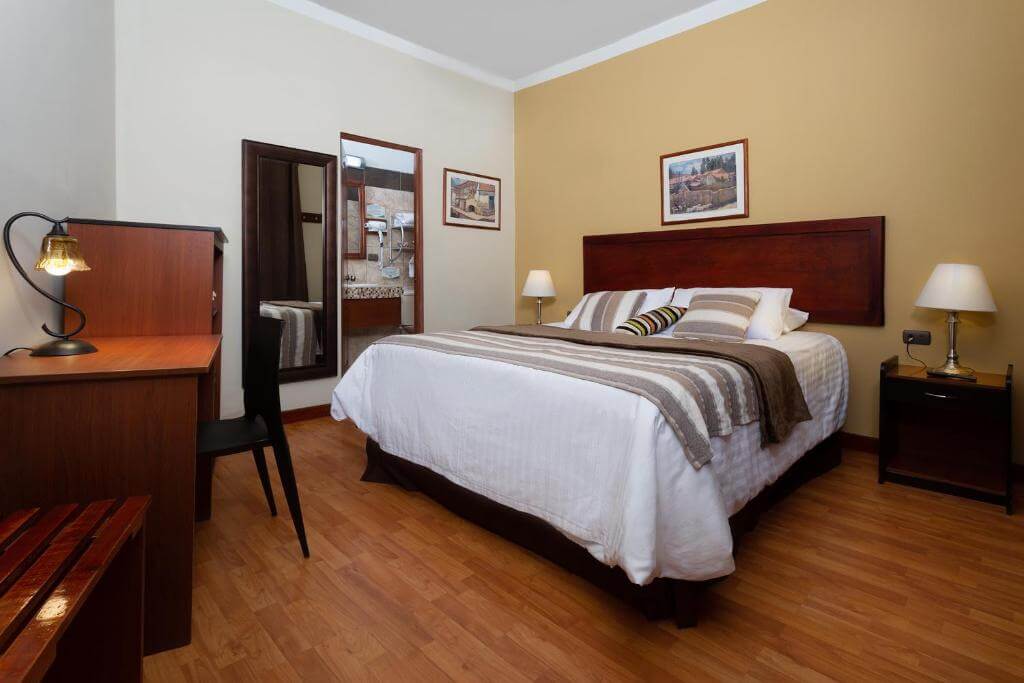
This budget-friendly hotel is also housed in a comfortable, restored colonial house. The location is central, so you’re within walking distance of most of the attractions in the city. The rooms are en suite with private bathrooms, and there’s a courtyard garden that provides a peaceful break from the city buzz.
CIRQA | Best Luxury Hotel
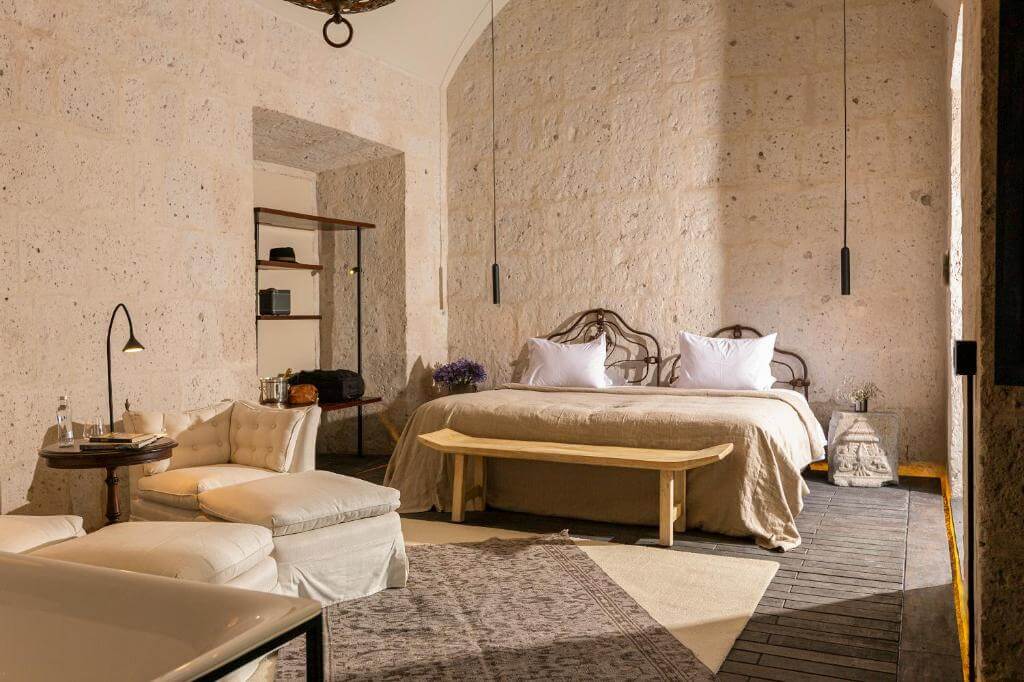
Experience celebrity treatment and world-class service at this chateau. CIRQA offers luxurious rooms with exceptional facilities. Get some spa treatments with local botanicals and dine on gourmet Peruvian cuisine on the rooftop terraces. The hotel is in a prime location, with easy access to major attractions.
Le Foyer Arequipa | Best Hostel
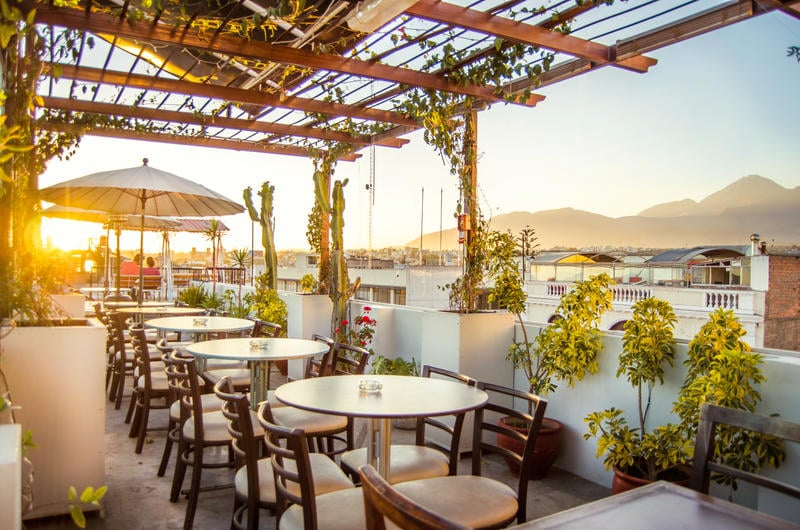
This restored colonial mansion is a short walk away from the Plaza de Armas and is one of my favourite hostels in Peru. Facilities like breakfast on the terrace with volcano views, Wi-Fi, and shared kitchen make this hostel a top choice. No wonder the place has been top-rated by Lonely Planet for twenty years.
Day 3 in Peru: Colca Canyon
Time to leave the city and head deep into one of the world’s deepest canyons. Colca Canyon is twice as deep as the Grand Canyon – yes, this is a geographical flex.
Stop 1: Cruz del Condor (Condor Watching Spectacle)
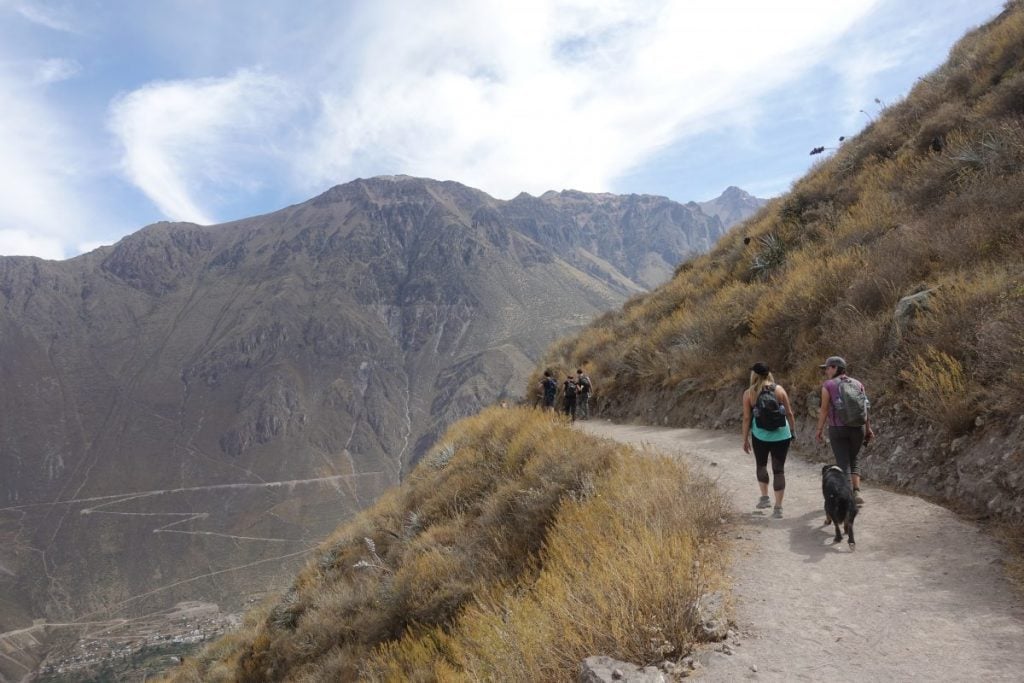
- Why it’s awesome: You get to see the endangered condors soar above the canyon.
- Cost: Colca Canyon tourist ticket starts at $23.
- Food recommendation: Pack energy bars. The high altitude affects many travellers, and there’s no food available at the viewpoints.
Set your alarm for 4:30 am because watching Andean condors soar above Colca Canyon is one of South America’s most memorable wildlife encounters. With wingspans stretching up to 10 feet and lifespans reaching 70 years, these majestic birds make for a special sight. Condors ride the thermal currents rising from the canyon’s depths and typically appear between 8–10 am. So, the earlier you arrive, the better your chances of front-row views and crowd-free photo ops.
The Cruz del Condor viewpoint sits above Colca Canyon, which is one of the deepest canyons in the world at over 3,270 meters deep. That’s nearly twice as deep as the Grand Canyon. The cliffs and rising mist provide a surreal backdrop as condors glide just meters overhead. Local guides will tell you about condor behaviour and its cultural significance: these birds were sacred messengers between earth and sky in Inca cosmology.
Tip: Dress in warm layers; mornings are cold.
Stop 2: Chivay & Yanque
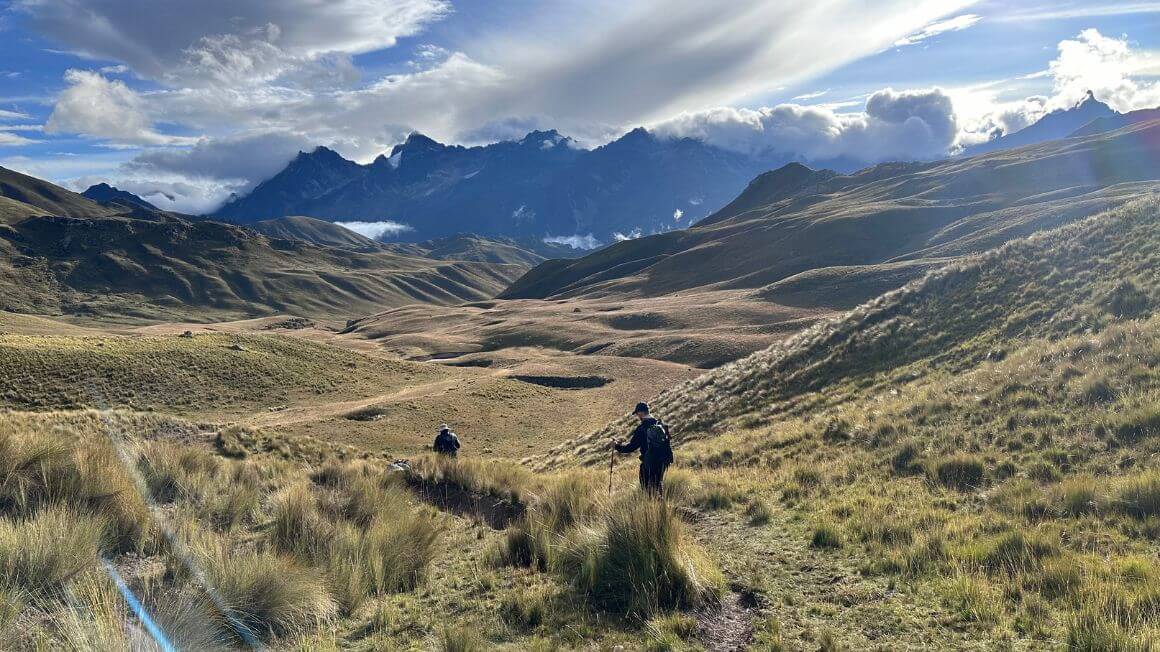
Photo: @willhatton__
- Why it’s awesome: You get to experience authentic and traditional Andean village life.
- Cost: Village visits are usually included in tour packages.
- Food recommendation: Try fresh quinoa soup at Village Kitchens.
After condor watching, explore the Andean villages where ancient traditions still shape daily life. In Chivay, the region’s commercial heart, the bustling Sunday market is a must-see. Locals come in vibrant attire and trade alpaca wool, quinoa varieties, and handwoven textiles, often using barter alongside cash.
Yanque, just down the road, offers an even more authentic village experience. Life goes on here as it has been for centuries. There are stone houses, active agricultural terraces from ancient times, and a breathtaking baroque church. The locals wear their traditional embroidered clothing normally, not for tourist shows.
Both villages show the real, unfiltered Andean life. Children still learn the indigenous Quechua language first, families still raise guinea pigs for feasts, and traditional herbal medicine remains common.
Stop 3: La Calera Hot Springs
- Why it’s awesome: These are therapeutic hot springs with mountain views!
- Cost: Hot springs entry fee ($4.50)
- Food recommendation: Try pachamanca (underground earth oven cooking) if staying overnight.
The best way to end your Colca Canyon journey is with a refreshing dip in the natural hot springs of La Calera. Spring’s waters are rich in minerals and remain warm all year round, despite the cold mountain air. There are several pools, ranging from soothing to steamy, so it’s the ultimate way to unwind. No wonder La Calera has been a popular bathing spot for the locals for centuries.
If you plan to stay overnight, base yourself in Cabanaconde, a peaceful village on the canyon’s edge. This traditional Andean community offers breathtaking sunrise views and access to epic trekking routes descending into the canyon. Local families offer homestay accommodation, where you can experience rural Andean life, if you choose to take up the offer.
Spending the night turns Colca from a rushed day trip into a cultural experience. If you stay, expect starry nights and early morning hikes. If you don’t stay, you will return to Arequipa.
Where to Stay in Colca Canyon – Day 3
Casa Andina Classic Colca | Best Budget Hotel
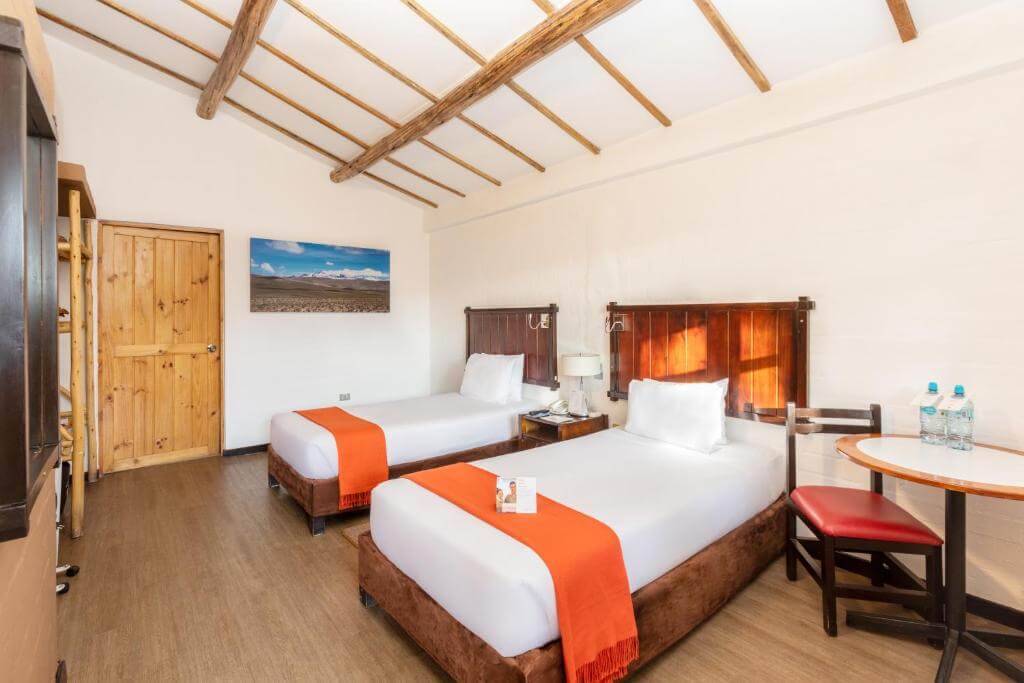
Casa Andina Classic Colca is centrally located near markets and hot springs. The hotel blends modern comfort with rustic charm, offering heated, oxygen-enriched rooms ideal for high-altitude stays. They serve traditional Peruvian dishes that are perfect after long canyon hikes. The private rooms have reliable amenities and professional hospitality.
Las Casitas del Colca | Best Luxury Hotel
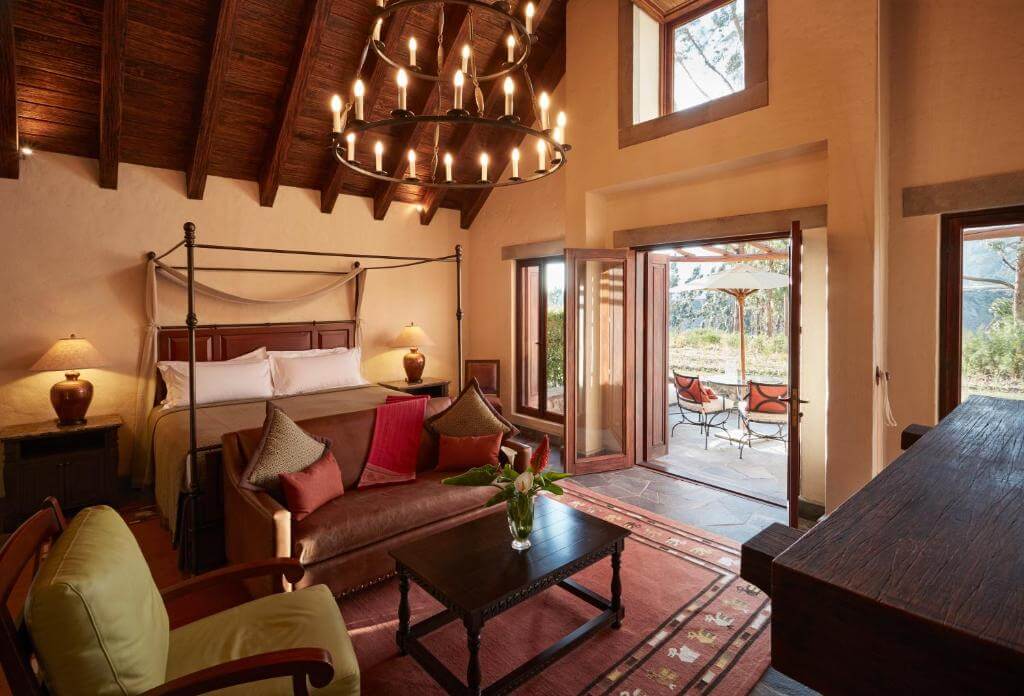
Private villas with canyon views, personal terraces and fireplaces -Las Casitas del Coca knows how to treat its guests lavishly. You will enjoy a spa inspired by Andean traditions and gourmet dining featuring local ingredients. The hotel also provides personalized excursions, like condor watching tours, cultural visits with local communities, and exclusive canyon treks.
Lonko Central | Best Hostel
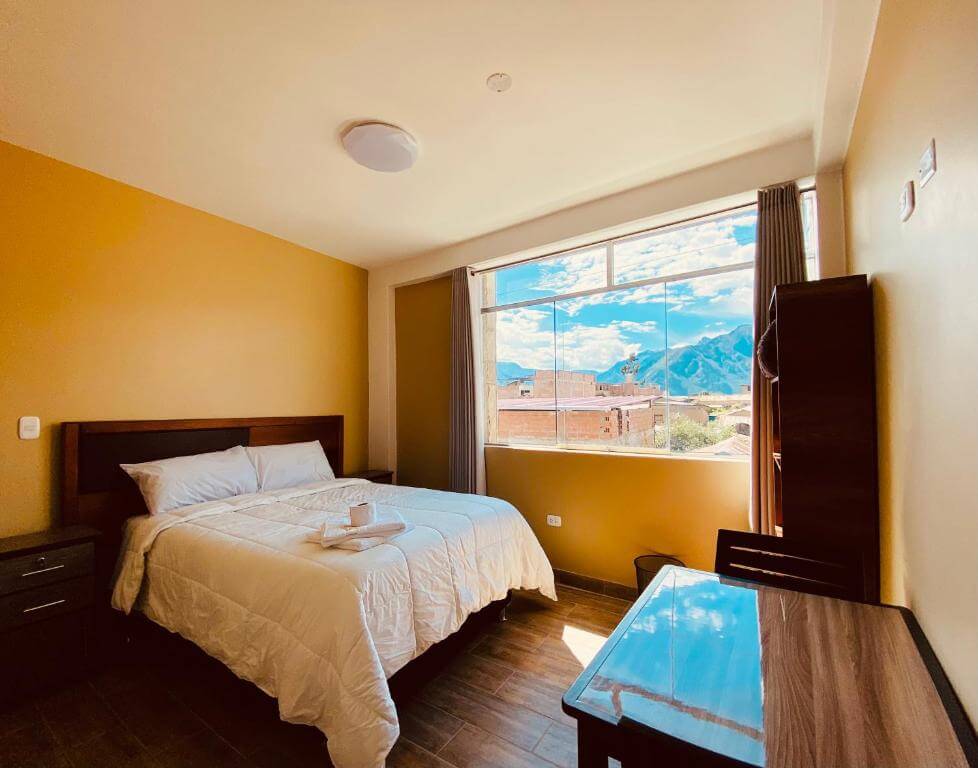
Lonko Central is in central Chivay and comes with cosy dorms, hot showers, and a friendly, social vibe. The hostel organises early morning condor-watching tours and provides packed lunches for trekkers. Walkable to the hot springs and local eateries, it’s a perfect base for budget-friendly Colca Canyon adventures.
Day 4 in Peru: Cusco
Take a morning flight to Cusco, or a scenic bus ride if you’re feeling adventurous. We have covered Cusco in detail in the 7-day Peru itinerary, so we’ll just highlight some of the basics here:
Stop 1: San Blas Artisan District
- Why it’s awesome: Authentic artisan workshops where you can watch craftsmen work using traditional Inca techniques
- Cost: Free to explore.
- Food recommendation: Grab coca tea and quinoa soup at Green Point or L’atelier
Stop 2: Qorikancha Temple
- Why it’s awesome: Best-preserved example of Inca stonework.
- Cost: Entry ($5)
- Food recommendation: Try local comfort food like adobo or chicha morada.
Stop 3: San Pedro Market
- Why it’s awesome: Real local market experience with exotic Amazonian fruits and traditional foods at local prices
- Cost: Free to enter, $1–3 for juices, empanadas, or woven goods
- Food recommendation: Order rocoto relleno (stuffed peppers) from the market – spicy and filling, yum!
Where to Stay in Cusco – Day 4
Day 5 in Peru: Sacred Valley + Ollantaytambo
As they say, Sacred Valley is your deep breath between Cusco and Machu Picchu. On day 5 of our 10-day Peru itinerary, we go to the Sacred Valley and visit the Ollantaytambo ruins. We have covered these places in two days in the 7-day itinerary, so for this itinerary, we’ll pack the main stops in one day.
Stop 1: Pisac Ruins + Market
- Why it’s awesome: Less crowded than other Sacred Valley sites, but with equally epic Inca terraces and mountain views
- Cost: Included in the Boleto Turístico (Cusco) (sightseeing ticket for tourists covering a number of sites), approx. $20-25
- Food recommendation: Try cuy chactado (fried guinea pig) at local restaurants, it’s Peru’s most traditional protein
Stop 2: Ollantaytambo Ruins
- Why it’s awesome: The only living Inca city where locals still inhabit original buildings, plus the site of the greatest Inca victory over Spanish forces
- Cost: Included in the Boleto Turístico (Cusco) (sightseeing ticket for tourists covering a number of sites), approx. $20-25
- Food recommendation: Try fresh trout from local streams, perfectly grilled with Andean herbs at Killa Wasi restaurant
Activity: Train to Aguas Calientes
We recommend taking the evening train from Ollantaytambo to Aguas Calientes, so you are refreshed and ready for your early morning Machu Picchu visit and trek. The train takes about 1 hour 45 minutes, passing through stunning Sacred Valley landscapes that blend Inca and colonial influences. PeruRail and Inca Rail run multiple daily trains catering to all budgets and comfort levels. The route follows the Urubamba River through cloud forests, shifting from high-altitude valleys to lush subtropical vegetation.
Tip: It’s best to book your tickets early, especially for peak season (May-September), as trains fill fast.
Where to Stay in Ollantaytambo – Day 5
Day 6 in Peru: Aguas Calientes (Machu Picchu)
Machu Picchu is one of those places that makes the early wake-up totally worth it. Aim for the first shuttle up to the site to beat the crowds and catch that misty morning magic. Since we’ve already covered the full Machu Picchu experience in the 7-day itinerary, we won’t repeat all the details here – just the essentials. For this version of the trip, you’ll be visiting as a day trip and heading back to Cusco by evening for the night. It’s a long day, but an unforgettable one.
Stop 1: Early Morning Machu Picchu Entry
- Why it’s awesome: The entire scene is magical – mist curling off the stone walls, llamas roaming freely.
- Cost: Entry tickets cost around $45 for adults, plus $12 for the shuttle bus (book well in advance online).
- Food recommendation: Pack snacks from Aguas Calientes, as no food is sold inside the ruins.
Stop 2: Huayna Picchu or Inti Punku (Sun Gate) (Optional)
- Why it’s awesome: You get panoramic views of Machu Picchu and quieter trails
- Cost: Additional $15-20 if you add Huayna Picchu to your Machu Picchu ticket. Sun Gate is usually included in the Machu Picchu ticket (depending on the circuit).
- Food recommendation: Bring energy bars and plenty of water. Both hikes are physically demanding at altitude.
Activity: Return to Cusco by train
Done with your awesome Machu Picchu adventure? Your next stop in this 7-day Peru itinerary is back to base in Cusco. Hop on the evening train from Aguas Calientes and take the scenic ride through the Sacred Valley. Book a window seat and keep your camera ready for the stunning mountain scenes and captivating sunset shots reflecting off the Urubamba River.
Where to Stay in Aguas Calientes – Day 6
Day 7 in Peru: Cusco (Rainbow Mountain Trek)
Brace yourself for another early wake-up call, because in Peru, the best rewards come with a sunrise. Take the earliest morning tour bus from Cusco to Rainbow Mountain, stop en route at a village for breakfast and fuel up for the day.
Stop 1: Vinicunca Rainbow Mountain
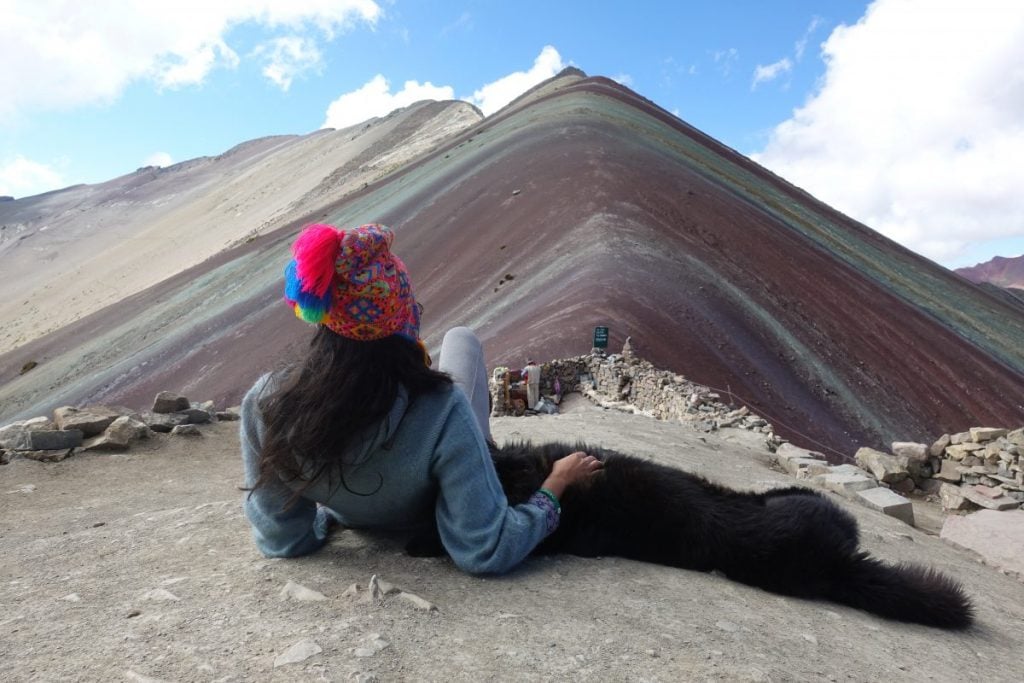
- Why it’s awesome: It is Peru’s most Instagram-famous natural wonder, why else?
- Cost: Full-day tours ($24-36), entrance fee approx. ($6-7)
- Food recommendation: Pack Coca Leaves, Coca tea and energy snacks from Cusco as these will be essential for altitude sickness prevention. Keep hydrated.
Rainbow Mountain, locally known as Vinicunca, is one of Peru’s most stunning natural wonders, where layers of mineral deposits create vibrant streaks of red, yellow, and turquoise. This colourful landscape paints a surreal picture, making it the perfect spot for some breathtaking photography.
Prepare yourself before this hike by spending some time acclimatising to high altitudes in Cusco. As with the other treks, it’s best to go very early to beat the crowds. Most tours depart Cusco around 4 am, which is recommended if you want to catch the mountain’s colours before the afternoon clouds roll in.
The trek begins at 4,326 meters and climbs to a breathtaking 5,200 meters. Yes, it’s a very challenging hike, due to extreme altitude and unpredictable weather, but totally worth it. The final ascent is a steep trail, where even fit hikers may feel the effects of altitude sickness. But the ultimate viewpoint is rewarding panoramic views of rainbow-striped peaks framed by snowy peaks.
Tip: Weather at altitude changes fast, so dress in layers and bring waterproof gear, even in the dry season.
Day 8 & 9 in Peru: Puerto Maldonado
Ready to swap mountains for the jungle? Take a short flight from Cusco to Puerto Maldonado, the gateway to Peru’s Amazon. From the airport on the Madre de Dios River, hop on a canoe to ride through the rainforest to your lodge.
Stop/Activity 1: Canopy Walk Adventure
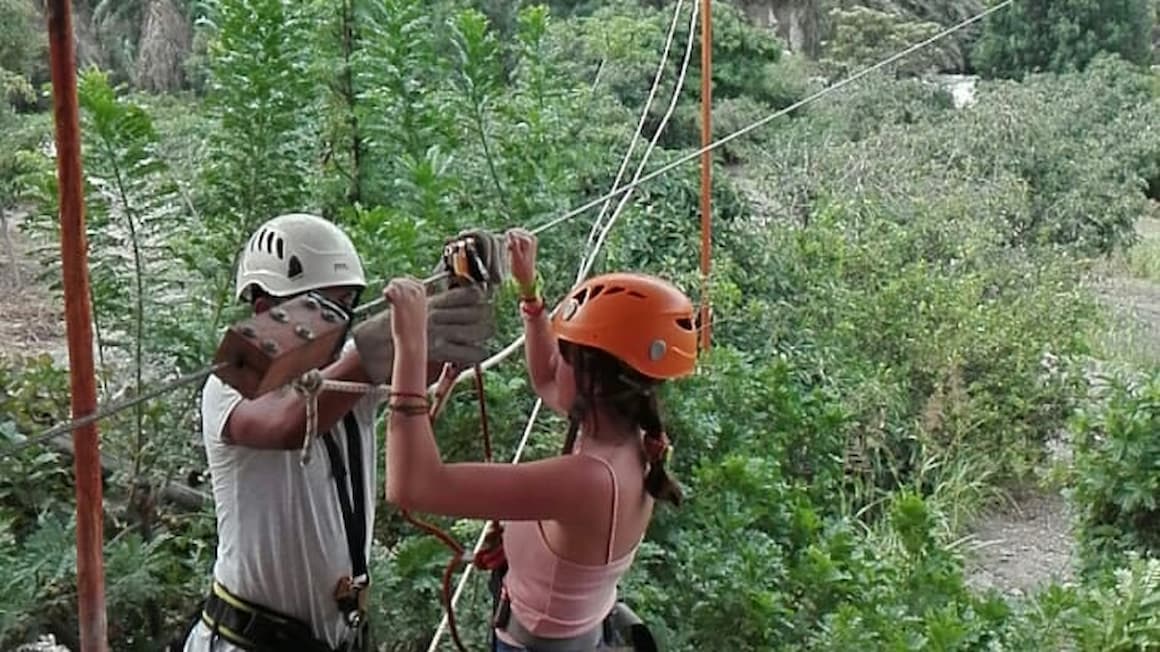
Photo: @amandaadraper
- Why it’s awesome: Excellent wildlife spotting and photography viewpoints.
- Cost: Usually included in lodge packages.
- Food recommendation: Sample exotic jungle fruits during canopy breaks.
Tambopata’s canopy walks offer a rare opportunity to experience the Amazon from above. The suspended bridges and observation platforms are positioned 30 to 40 meters above ground, where most of the rainforest’s wildlife activity occurs. From these elevated walkways, you will be up close with wildlife such as toucans, macaws and harpy eagles.
The walkway system has multiple observation stops with varying angles for watching. Simply put, the place is perfect for wildlife spotting and photography. If you go in early afternoon, you will catch most of the hundreds of bird species.
Be prepared fitness-wise for the walks, since it will involve ladder climbs and swaying suspension bridges. Safety gear is provided, and the guides ensure its proper usage, so you need not worry.
Stop/Activity 2: Night Trail & Caiman Spotting
- Why it’s awesome: You get to see caimans and listen to the sounds of the jungle.
- Cost: Included in most lodge packages.
- Food recommendation: Enjoy traditional Amazon fish soup for dinner, made with fresh river catch, prepared with local herbs and vegetables
Exploring the Amazon at night is a completely different experience, as many animals become active after dark. The tour guides carry red-filtered flashlights to avoid disturbing the wildlife. On the night trail, you’ll see all the nocturnal frogs, insects, birds and reptiles become active. From howler monkeys to buzzing insects, nighttime in the forest is full of sounds.
Caiman spotting is possible on silent boat rides along the riverbanks. In the darkness, guides use special lights to find them without disturbing them. And when you do spot them, you only see their glowing eyes above the water
Caiman spotting is often a highlight, with silent boat rides along the riverbanks where only their glowing eyes can be seen above the water. Guides use special lights to find them without getting too close, keeping both animals and visitors safe. Other night sightings may include bats, owls, and even giant river otters.
Tip: Temperatures drop after dark, so wear long pants and keep insect repellent.
Stop 3: Morning River Wildlife Excursion
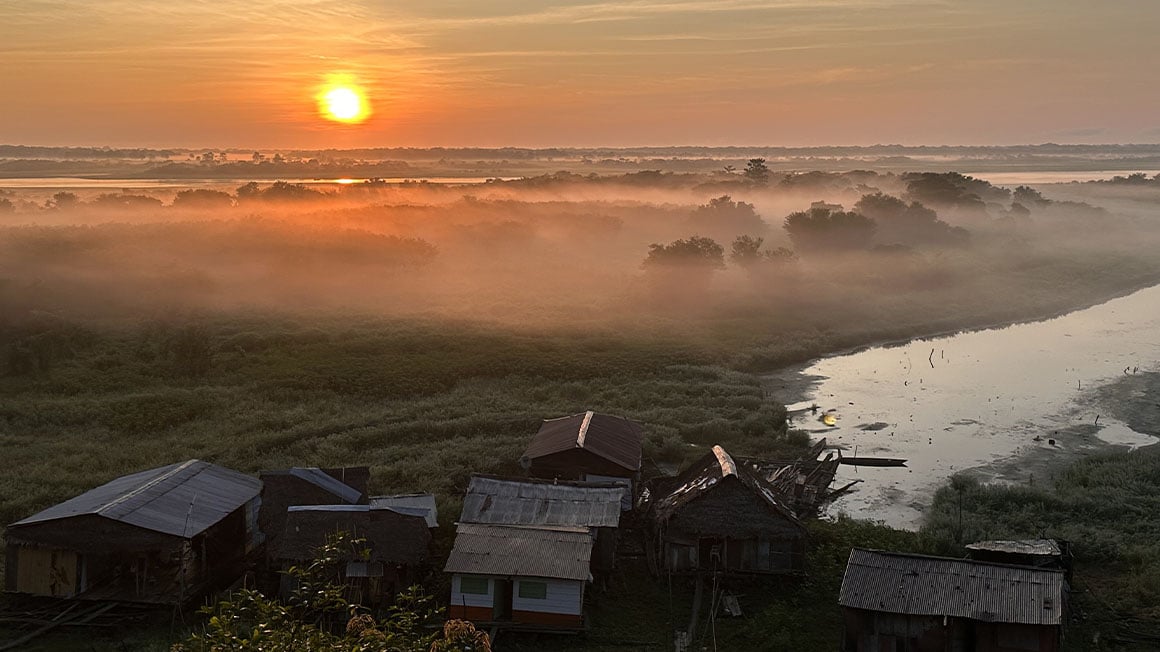
- Why it’s awesome: Guaranteed macaw sightings plus spotting camouflaged sloths and monkeys
- Cost: Included in most lodge packages.
- Food recommendation: Pack Brazil nuts collected fresh from the jungle floor.
As with the mountains, early morning boat trips are the best time to see Amazon wildlife. As the sun rises, animals like monkeys, macaws, and sloths come out to eat before the day gets too hot. Guides use quiet electric boats to ride along the Madre de Dios River, so you can get close without scaring the animals. You might hear howler monkeys calling loudly through the forest. It’s a sound you’ll never forget!
One of the highlights is visiting a macaw clay lick. Dozens of colourful birds, like scarlet and blue-and-yellow macaws, gather here between 6 and 9 am to eat special clay that helps their digestion. You can also spot slow-moving sloths hanging in trees, which your guide will help you find. Along the river, you’ll pass through many different habitats, and with luck, you might even see playful river otters or pink dolphins swimming nearby.
Stop 4: Oxbow Lake

- Why it’s awesome: You get to paddle through the oxbow lakes.
- Cost: Oxbow Lake paddling is included in tour packages
- Food recommendation: Try traditional fish wrapped in banana leaves.
Oxbow lakes are some of the Amazon’s most peaceful and untouched spots. The best way to explore them is by paddle canoe, which lets you move silently across the water without scaring away animals. You’ll often see giant water lilies, colourful birds, and maybe even monkeys or capybaras by the shore. The dark water acts like a mirror, perfectly reflecting the trees and sky.
Local community members often lead these lake tours. They know the forest better than anyone, with knowledge passed down through generations. They can spot animal tracks, sounds, and hidden signs that most visitors would miss. Their guidance not only helps you see more wildlife but also supports local traditions and keeps tourism respectful and real. It’s a calm, magical experience and one of the best ways to connect with Amazon.
Where to Stay in Puerto Maldonado – Days 8 & 9
Copasu | Best Budget Hotel
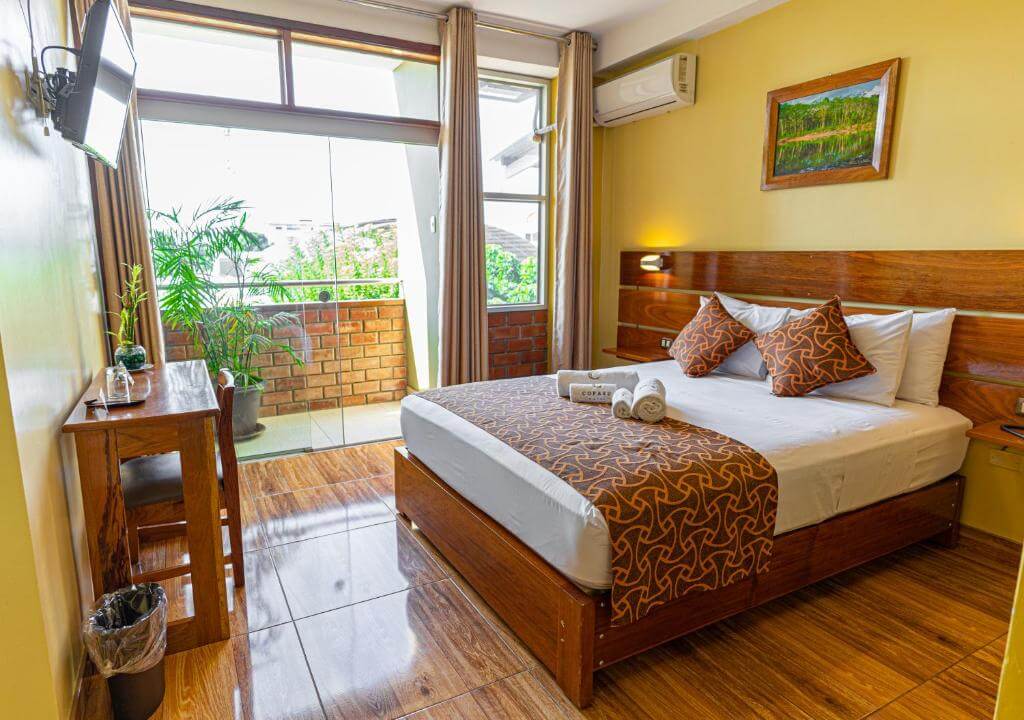
Copasu offers excellent value with air-conditioned rooms, private bathrooms, and easy access to Puerto Maldonado’s airport and riverfront. The on-site restaurant features regional Amazon dishes. It’s a great option if you’re seeking comfort, cleanliness, and convenience at mid-range prices.
Inkaterra Reserva Amazonica | Best Luxury Hotel
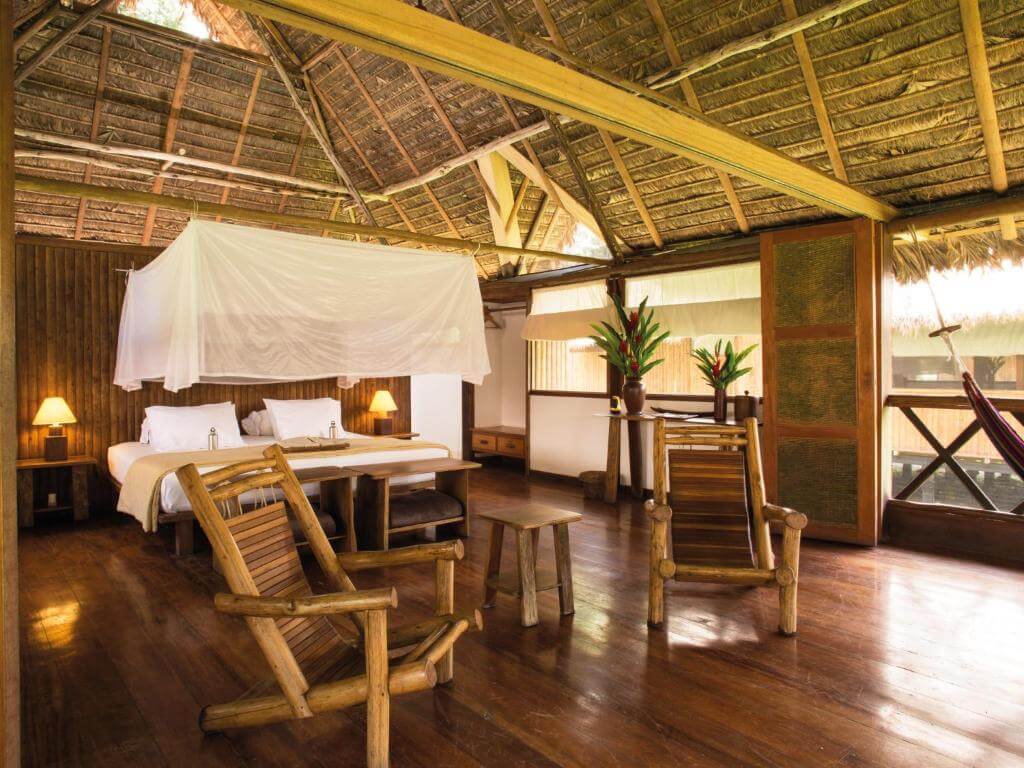
Inkaterra Reserva Amazonica blends luxury with sustainability, offering elegant cabanas on raised platforms deep in the rainforest. Each unit features private bathrooms and screened windows for full jungle immersion. You can enjoy gourmet meals with local ingredients and guided wildlife tours led by expert naturalists, which is ideal for an unforgettable Amazon escape.
Tambopata Hostel | Best Hostel
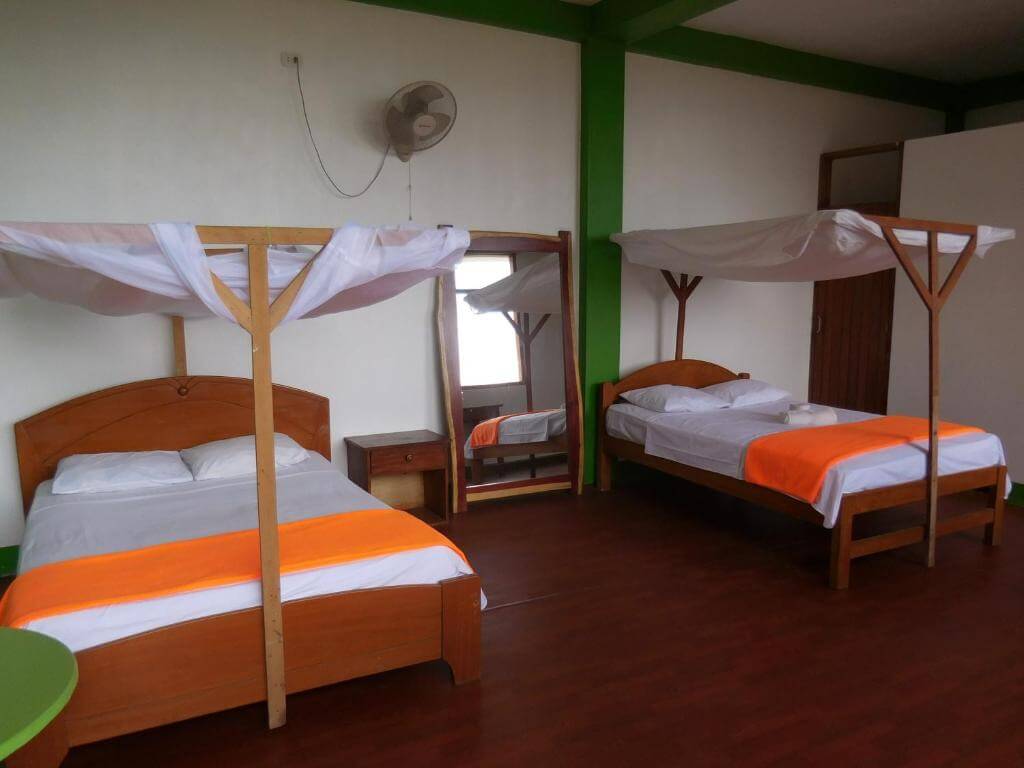
Tambopata Hostel is the top hostel choice in Puerto Maldonado, offering dorms and private rooms in a central location close to restaurants and tour offices. It provides clean facilities, hot showers, Wi-Fi, and secure storage. Friendly staff and group tours make it perfect for social travellers exploring the Amazon.
Day 10 in Peru: Lima
After breakfast, you’ll take the boat back to Puerto Maldonado, arriving with enough time to catch your flight to Lima. If you’ve got a few hours to kill before your connection home, squeeze in one final stroll along the coast. It’s a quiet, easy way to end the trip.
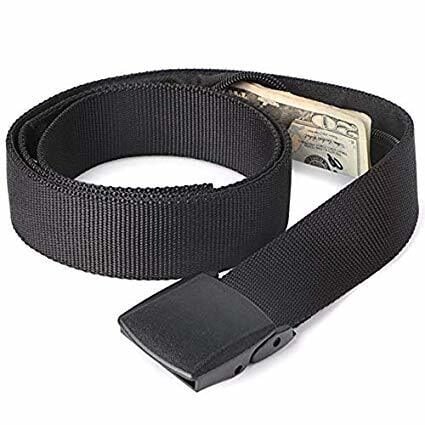
Stash your cash safely with this money belt. It will keep your valuables safely concealed, no matter where you go.
It looks exactly like a normal belt except for a SECRET interior pocket perfectly designed to hide a wad of cash, a passport photocopy or anything else you may wish to hide. Never get caught with your pants down again! (Unless you want to…)
Hide Yo’ Money!How to Get Around Peru
Buses in Peru are frequent and they are cheap. You can typically get to where you need to go by bus.
Avoid flying unless necessary. Slow travel is cheap travel. Whilst backpacking Peru, embrace this philosophy and you will save a lot of cash.
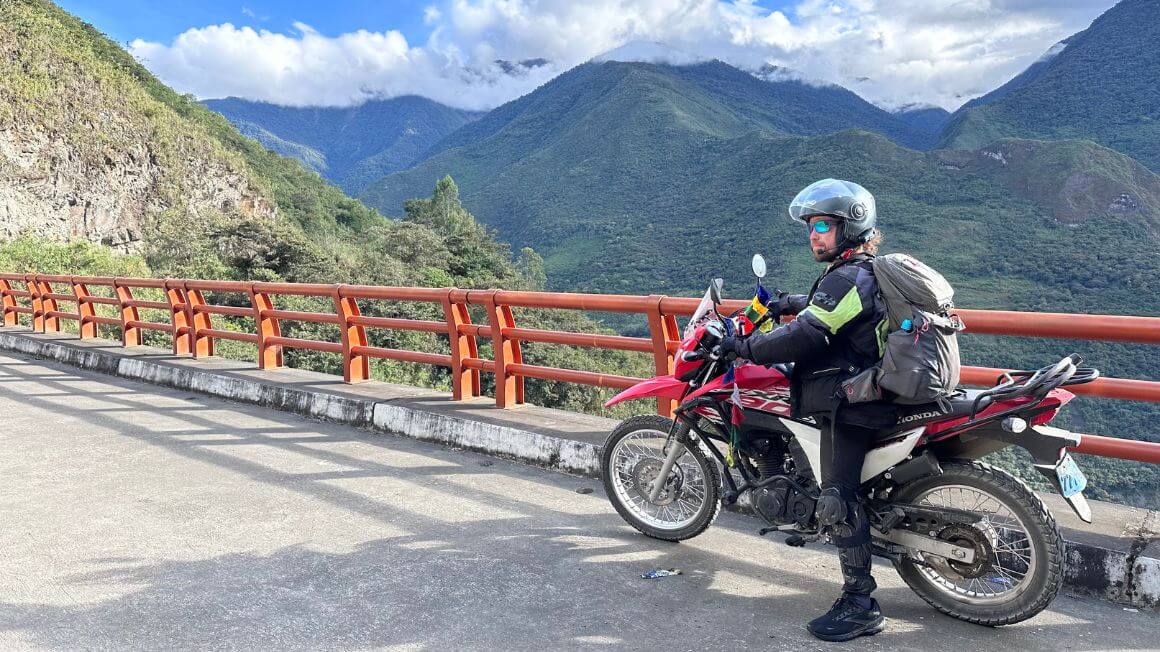
Photo: @willhatton__
Motorcycles and scooters are a big part of the culture for young males in Peru. They are abundant in just about every place you go, and you can find some pretty good deals if you are looking to score a bike. Always use your best judgment when going through the process of buying a motorcycle. Don’t buy a piece of shit that will leave you stranded in the middle of the Andes.
It is possible to rent motorbikes in Peru in some places where tourism is a bit more developed, for example, in Cusco. The prices vary but, typically, aren’t crazy expensive.
Having your wheels is a fantastic way to explore places that buses in Peru can’t take you. It is generally a good idea to have some degree of familiarity with motorcycles before you set off down some mountain road in the Andes. As always, be safe and always wear a helmet!
Staying Safe in Peru
Peru is a friendly and welcoming country, and most travellers have a safe and memorable trip by following a few simple precautions. The main concerns are petty theft in crowded areas and altitude sickness in the Andes. Both are easy to manage with awareness and planning. Every year, millions of visitors travel across Peru without serious problems, so safety shouldn’t stop you from exploring its amazing sights.
In cities like Lima and Cusco, stay in tourist-friendly neighbourhoods, especially at night. Avoid showing off valuables like expensive phones or cameras. Store your passport in your hotel’s safe. I usually carry a copy instead. Use trusted taxi apps like Uber or Beat rather than flagging down random taxis. Tourist police are present at popular spots and are helpful if you need assistance.
As for altitude sickness, it can affect anyone. It is more likely in Cusco or the Sacred Valley, which are both above 3,000 meters. Take your first day slow, drink coca tea, stay hydrated, and skip alcohol until you adjust. If symptoms become severe, it is better to descend immediately.
Tap water isn’t always safe to drink, so stick to bottled water unless you’re dining at reputable places. When it comes to street food, choose busy stalls with lots of locals, as they’re usually the freshest and safest options.
Don’t Forget Your Travel Insurance for Peru
Unfortunately, things can go wrong when you least expect them. This is why good travel insurance is essential before you head on your trip to Peru.
ALWAYS sort out your backpacker insurance before your trip. There’s plenty to choose from in that department, but a good place to start is Safety Wing.
They offer month-to-month payments, no lock-in contracts, and require absolutely no itineraries: that’s the exact kind of insurance long-term travellers and digital nomads need.
SafetyWing is cheap, easy, and admin-free: just sign up lickety-split so you can get back to it!
Click the button below to learn more about SafetyWing’s setup or read our insider review for the full tasty scoop.
Final Thoughts
So, whether you’ve got 7 days or 10 days, Peru is big on experience. The 7-day itinerary is ideal if you’re short on time but still want to hit the essentials, from Lima to Machu Picchu. It’s a solid introduction to the country’s highlights, with just enough breathing room to enjoy the ride.
If you’ve got a few extra days to spare, the 10 day itinerary in Peru lets you go deeper, trekking into Colca Canyon, reaching Rainbow Mountain, and heading into the Amazon for a taste of jungle life. It’s a bit more active, a bit more varied, and shows just how diverse Peru really is.
Whichever you choose, you’re in for stunning landscapes, delicious food, and a culture that stays with you. Just pack light, plan smart, and let Peru do the rest.
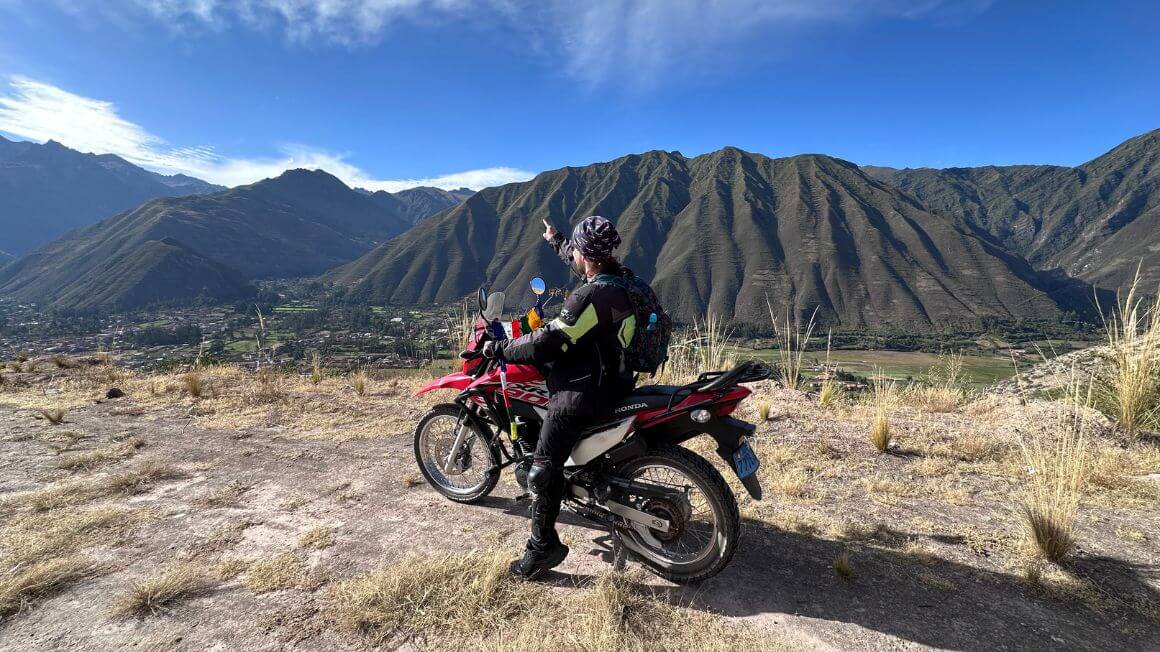
Photo: @willhatton__
- Check out our Backpacking Peru guide for in-depth info for your trip.
- Use our Where to Stay in Peru guide to plan your adventure.
- Then there are the most epic beaches in Peru for the beach bums.
- Backpackers and frugal travellers can use our budget travel guide.
Buy Us a Coffee!
A couple of you lovely readers suggested we set up a tip jar for direct support as an alternative to booking through our links, since we’ve decided to keep the site ad-free. So here it is!
You can now buy The Broke Backpacker a coffee. If you like and use our content to plan your trips, it’s a much appreciated way to show appreciation 🙂


